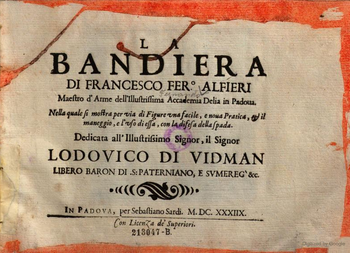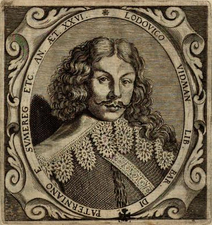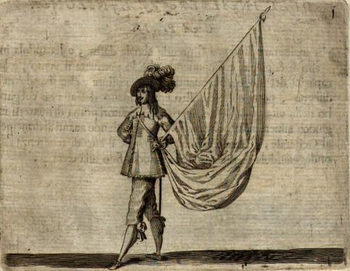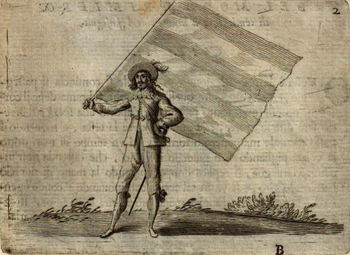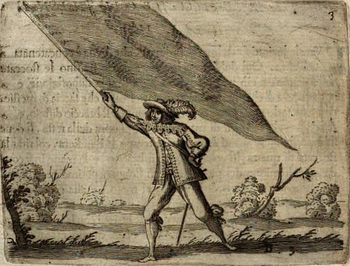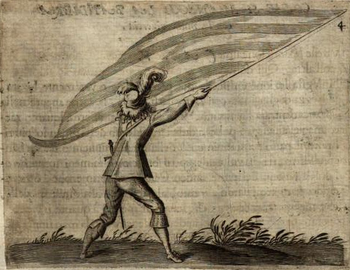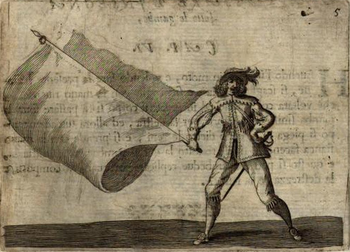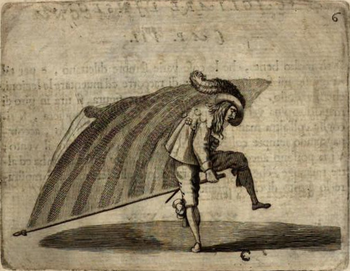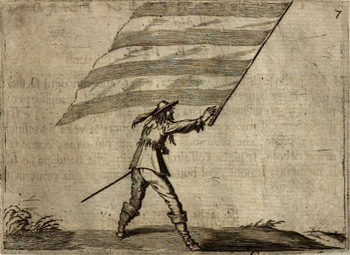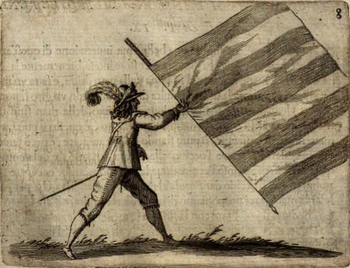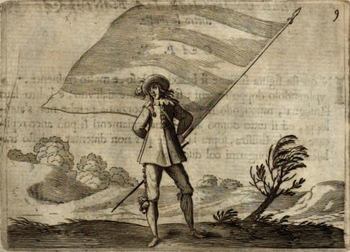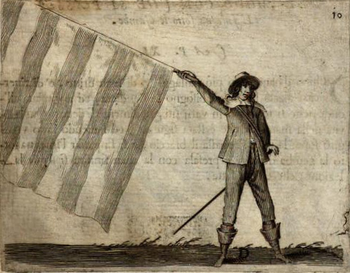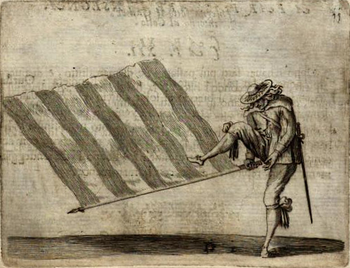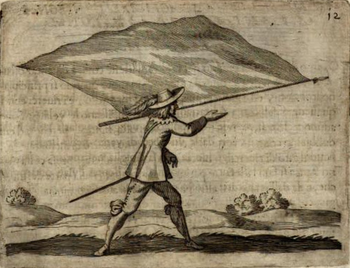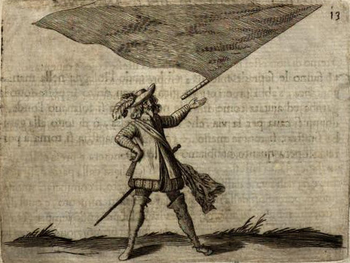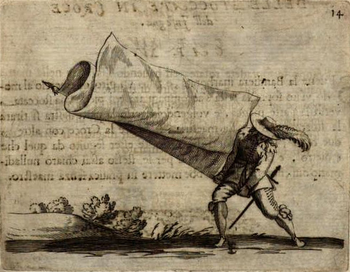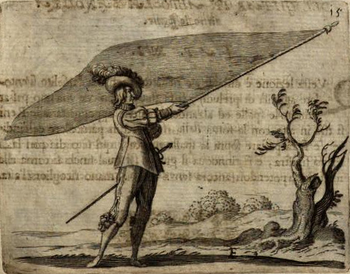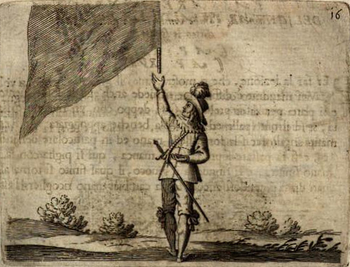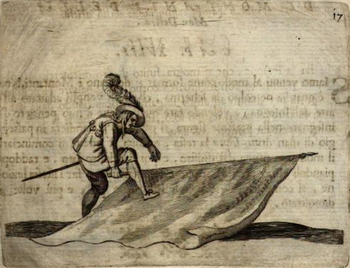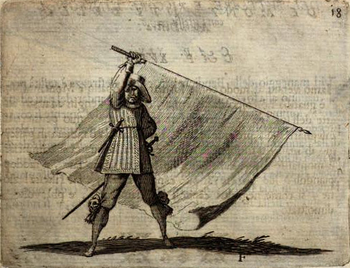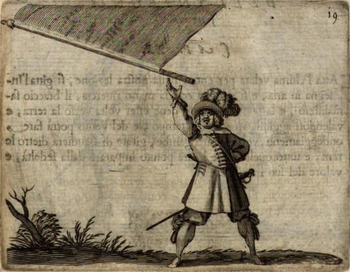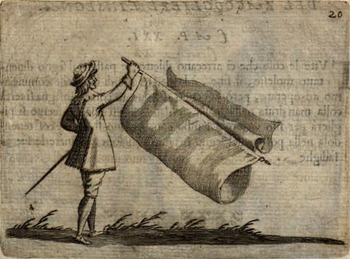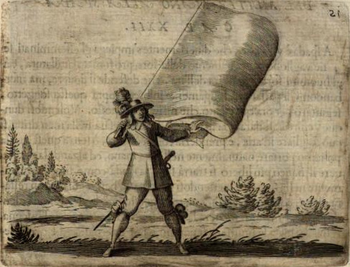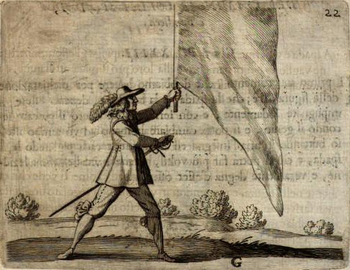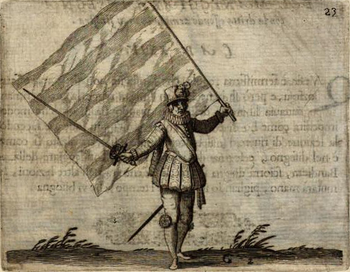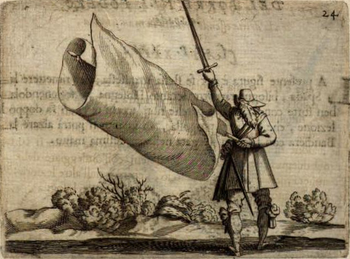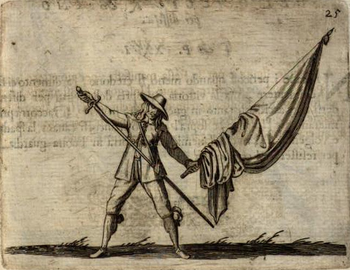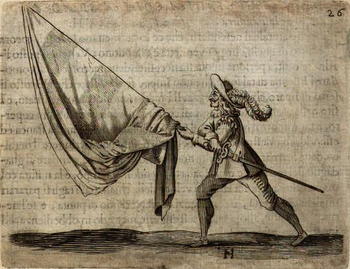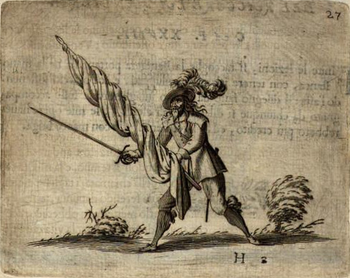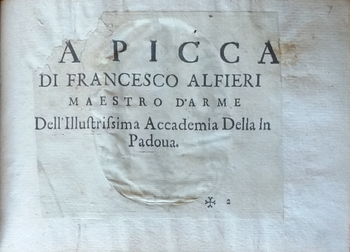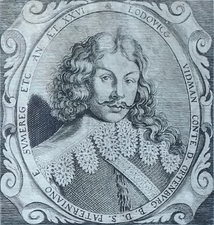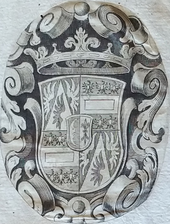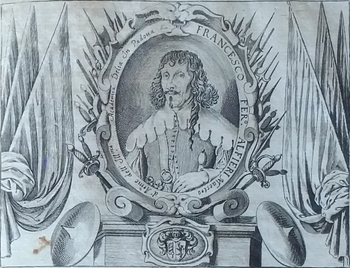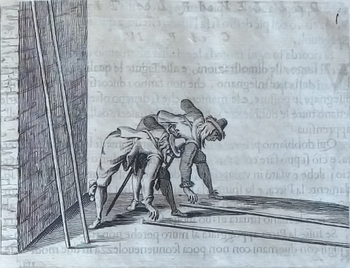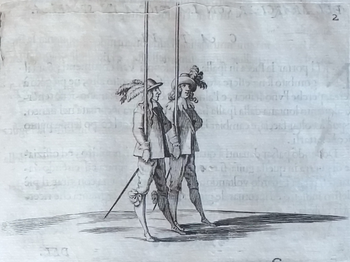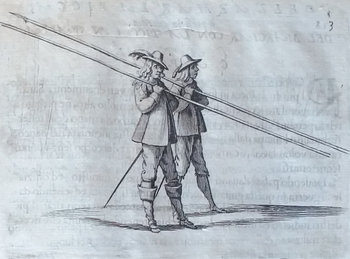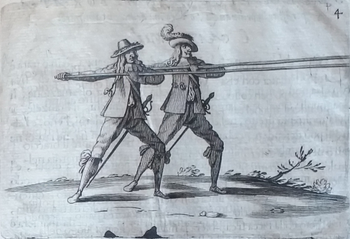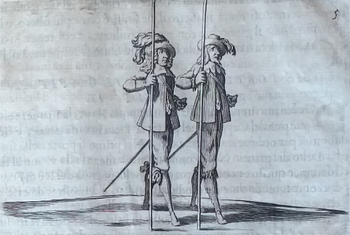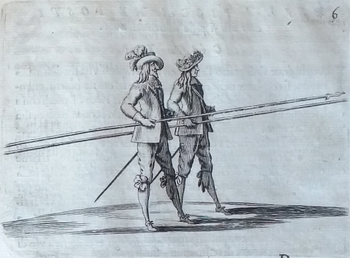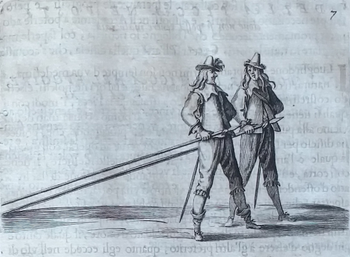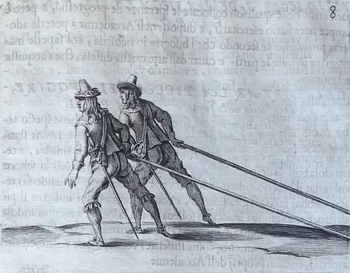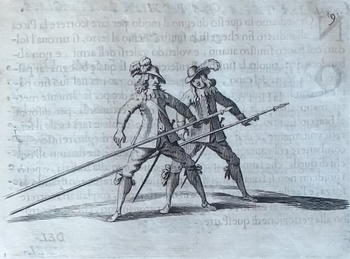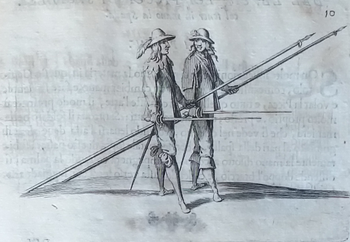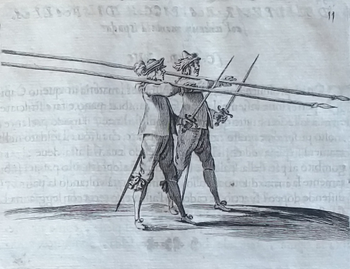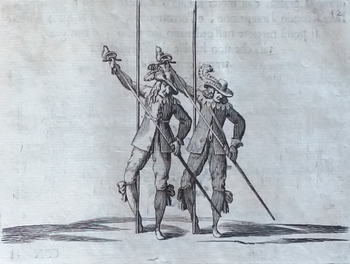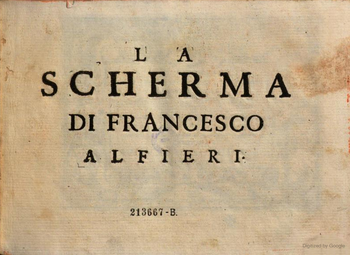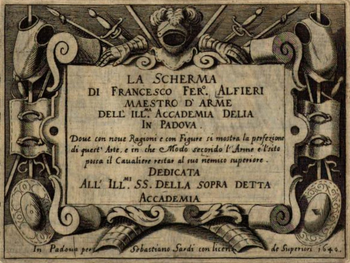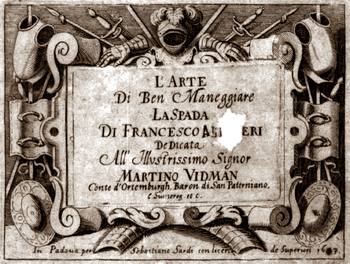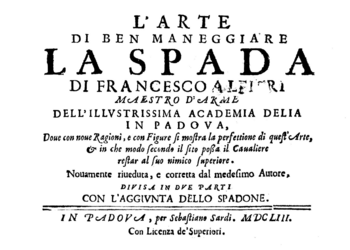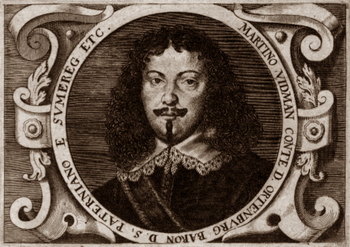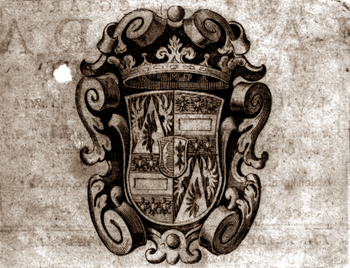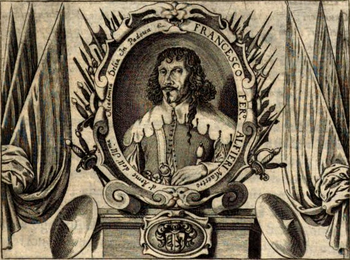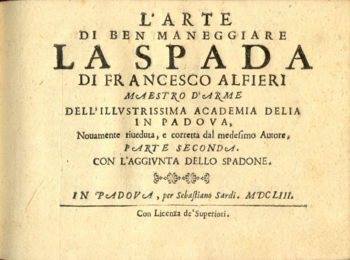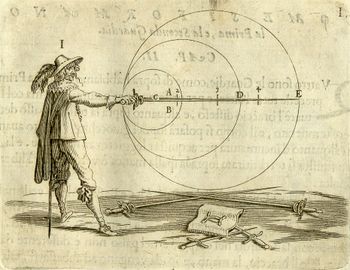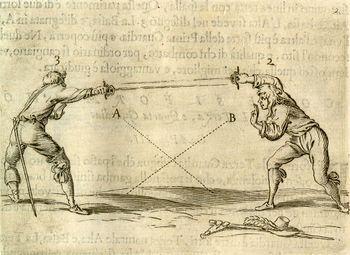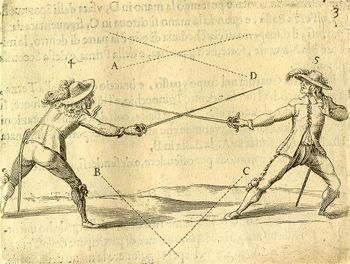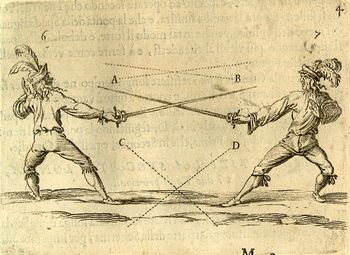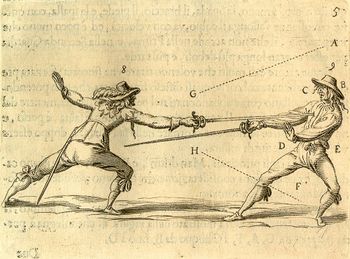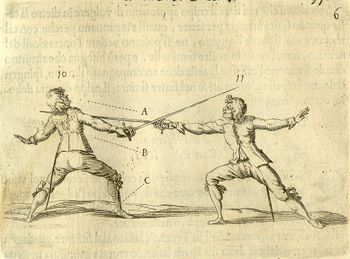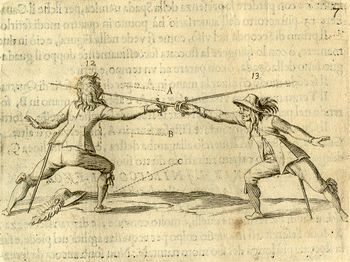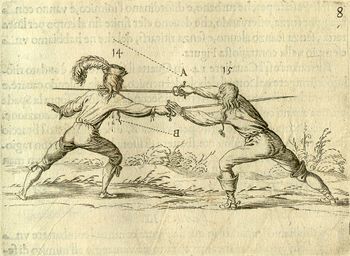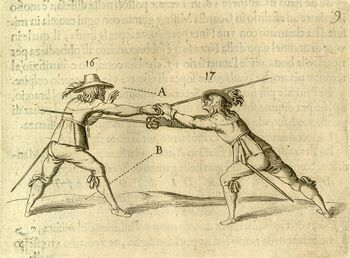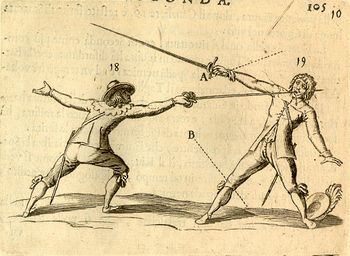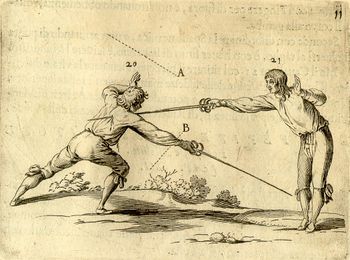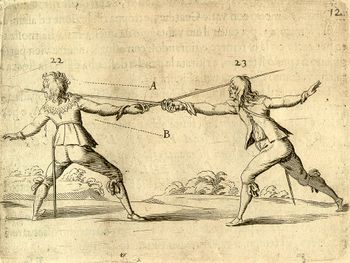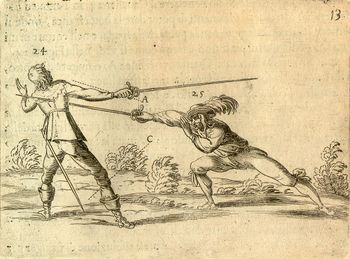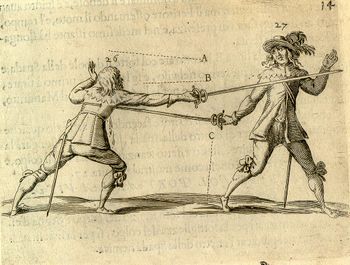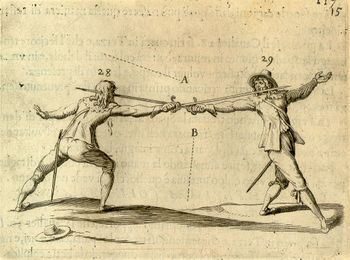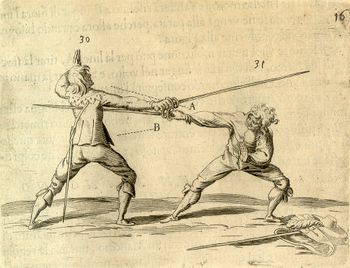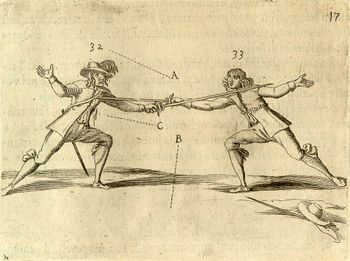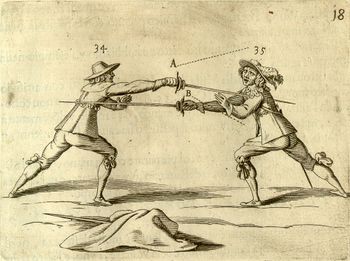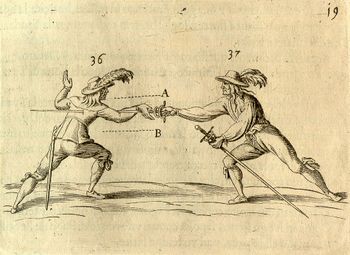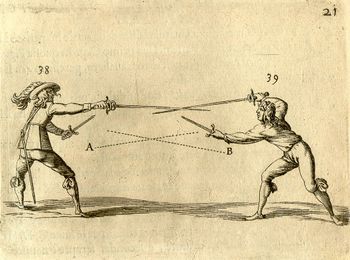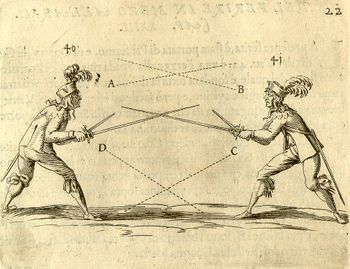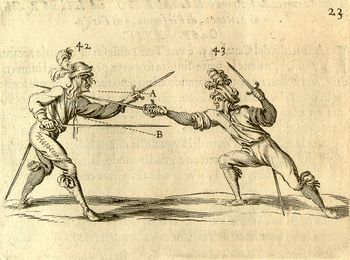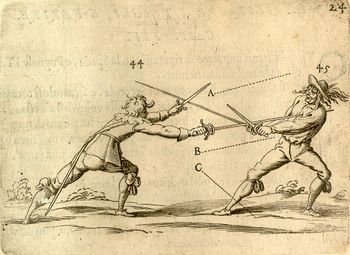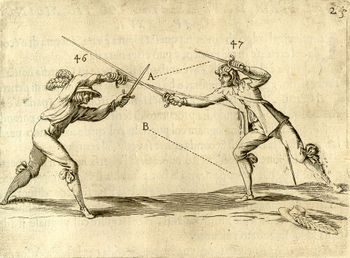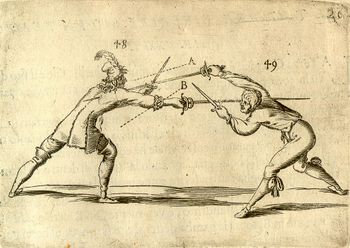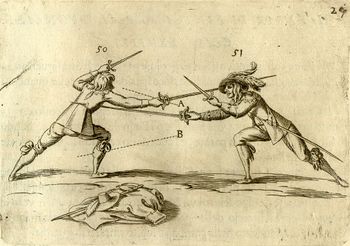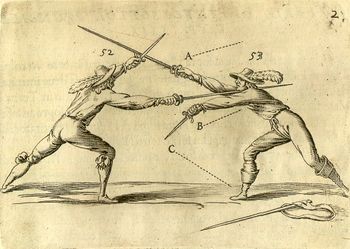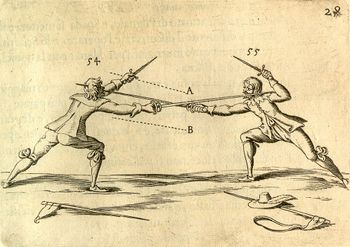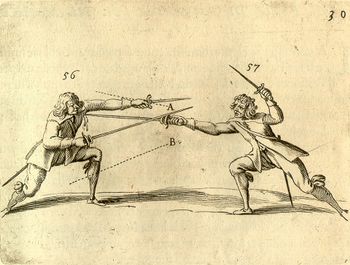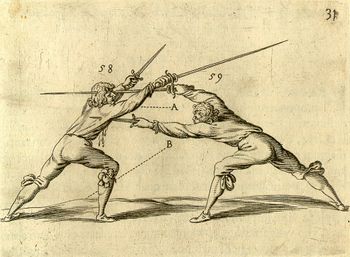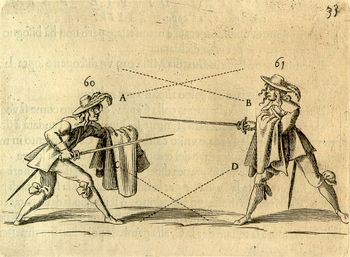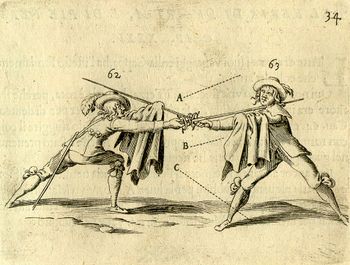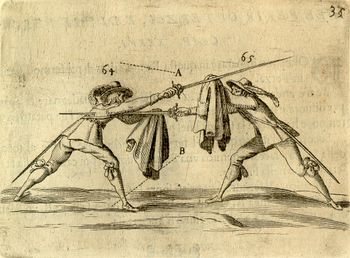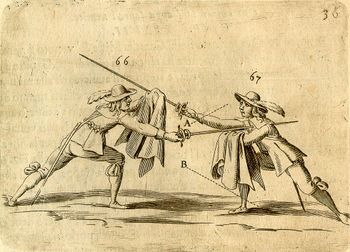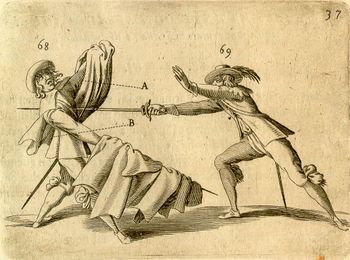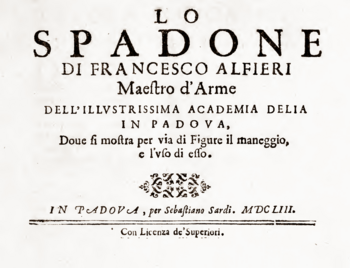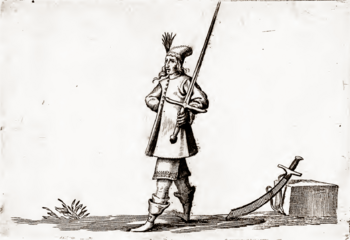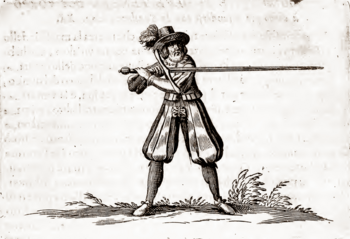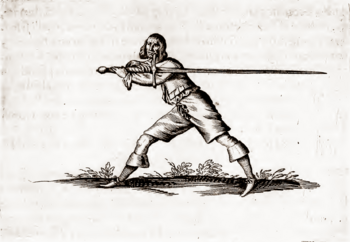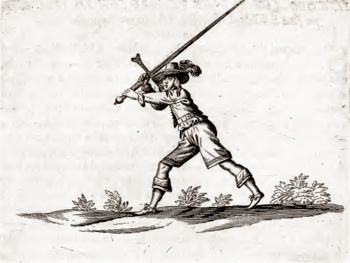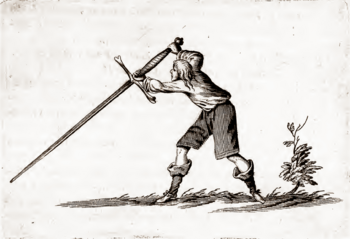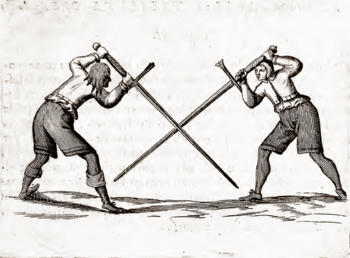|
|
You are not currently logged in. Are you accessing the unsecure (http) portal? Click here to switch to the secure portal. |
Difference between revisions of "Francesco Fernando Alfieri"
(→Temp) |
(→Temp) |
||
| Line 375: | Line 375: | ||
==Temp== | ==Temp== | ||
{{master begin | {{master begin | ||
| − | | title = | + | | title = ''La Scherma'' ("On Fencing") |
| width = 100% | | width = 100% | ||
}} | }} | ||
Revision as of 18:41, 15 August 2017
| Francesco Fernando Alfieri | |
|---|---|
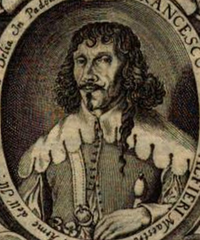 Portrait from 1640 | |
| Born | 16th century (?) |
| Died | 17th century |
| Occupation | Fencing master |
| Nationality | Italian |
| Genres | Fencing manual |
| Language | Italian |
| Notable work(s) |
La Picca (1641)
|
 |
Caution: Scribes at Work This article is in the process of updates, expansion, or major restructuring. Please forgive any broken features or formatting errors while these changes are underway. To help avoid edit conflicts, please do not edit this page while this message is displayed. Stay tuned for the announcement of the revised content! This article was last edited by Michael Chidester (talk| contribs) at 18:41, 15 August 2017 (UTC). (Update) |
Francesco Fernando Alfieri was a 17th century Italian fencing master. Little is known about his life, but Alfieri means "Ensign" which might be a military title rather than a family name. In his fencing treatise of 1640, he identifies himself as a master-at-arms to the Accademia Delia in Padua, and indicates that he had long experience at that time
In 1638, Alfieri published a treatise on flag drill entitled La Bandiera ("The Banner"). This was followed in 1640 by La Scherma ("On Fencing"), in which he treats the use of the rapier. Not content with these works, in 1641 he released La Picca ("The Pike"), which not only covers pike drill, but also includes a complete reprint of La Bandiera (complete with title page dated 1638). His treatise on rapier seems to have been especially popular, as it was reprinted in 1646 and then received a new edition in 1653 titled L’arte di ben maneggiare la spada ("The Art of Handling the Sword Well"), which not only includes the entirety of the 1640 edition, but also adds a concluding section on the spadone.
Contents
Treatise
Images |
Transcription (1638) | |
|---|---|---|
[i] LA BANDIERA DI FRANCESCO FER.º ALFIERI Maestro d'Arme dellʼIllustrissima Accademia Delia in Padoua. Nella quale si mostra per via di Figure una facile, e nova Practica, & il maneggio, e lʼuso di essa, con la difesa della spada. Dedicata allʼIllustrissimo Signor, il Signor LODOVICO DI VIDMAN LIBERO BARON DI .S: PATERNIANO, E SUMEREG` &c. IN PADOUA, per Sebastiano Sardi. M. DC. XXXIIX. Con Licenza de' Superiori. | ||
|
| ||
[48] DEL METTER MANO ALLA SPADA CAP. XXII. LA spada è unʼarma che diversamente sʼimpiega; glʼeffemminati se ne vagliono per ornamento della loro profumata attillatura, e agli uomini forti è ministra dʼira, che defende il dovere; ma riservandomi di parlar più longamente in breve sopra questo soggetto, seguitarò per ora quel tanto che mi sono proposto. Volendosi dunque venire a sfodrare la spada, se la bandiera sarà nella man dritta, si può scagliare in aria e prenderla con la sinistra, o senza questʼatto la possiamo portare naturalmente nellʼaltra mano, ed alzandola per avere il fianco più libero si trarrà fuor la spada come si vede chiaramente nella figura, e mettendosi ad un passo ben regolato non restarà di farsi conoscere sperimentato in questo nobile esercizio, e volendo cambiar mano, si metterà la spada sotto il braccio, e presa lʼInsegna, resterà armata la sinistra, e si potranno fare quei passaggi e quelle lezioni che si sono apprese nellʼarte. | ||
[50] DEL CAMINAR COLLA SPADA, e Bandiera. CAP. XXIII. IL primo auvertimento, che dobbiamo havere per dichiarazione della figura, si è, che la spada, e la bandiera, deveno essere, impugnate sodamente, e con fermezza, é libero il giocare secondo il genio, e si potrà cambiare la mano ad un tempo istesso buttando in aria lʼInsegna ed avanti, che cada pigliando la spada, e ciò si potrá far più volte, perche è una bellissima lezione, e veramente degna dʼesser osservata. | ||
[52] DEL MANEGGIAR LʼINSEGNA con la dritta essendo armata la man sinistra. CAP. XXIV. QUesta è fermissima regola, che lʼInsegna non deve mai essere oziosa, e però se bene la man sinistra regge la spada, rimane tuttavia libera la destra, e quando sia in qualche modo impedita come ho detto altre volte, tantʼè più lode, e facendo la lezione di rivescio il braccio sinistro si terrà alzato siccome è nel disegno, e formando i soliti seni collʼondeggiar della bandiera, sciorrà doppo il braccio, sʼentrerà nellʼaltra lezione, si mutarà mano, pigliando il vento; e ʻl tempo che vi bisogna. | ||
[54] DEL PORRE NEL FODERO la Spada. CAP. XXV. LA presente figura è per se stessa manifesta; per rimettere la spada bisogna raccorre accanto lʼInsegna, e sostenendola ben forte con la sinistra perché non tocchi terra, si fà doppo la lezione che ci siamo proposta, ed intanto si potrà alzare la Bandiera con lasciarla spiegata nella medesima mano. | ||
[56] DEL CACCIAR MANO per diffesa. CAP. XXVI. NAscano i pericoli quando meno si credono, lʼardimento ci fà combattere, ma la vittoria è propria della virtù per difendersi daglʼaccidenti tanto in guerra che in pace, si raccorrà primieramente lʼInsegna, e sopra il braccio manco si daverà la spada, e volgendo lʼasta verso il nemico si disporrà in buona guardia per resistere ad ogni offesa. | ||
[58] DELLA GUARDIA COLLA SPADA, e la Bandiera. CAP. XXVII. E Tanto naturale il difendersi che ce lo permettono le leggi, ancora contro quelli che per vendetta ci offendono. Venendo posto lʼAlfiere od altra persona in questa necessità, deve raccorre ed accomodare lʼInsegna di tale sorte che non impedisce la vista e che più tosto li serva di riparo, che di gravezza. Il braccio sarà alquanto incurvato eʻl sito della mano in terza, terrà il corpo in profilo per essere più coperto, e far minore il bersaglio, il corpo si posarà nella gamba stanca ed essendo il piè destro accanto libero, e leggiere potrà stringere il nemico; deve formare il passo che non sia molto sforzato, ed andare al guadagno del terreno, e della spada togliendoli il tempo e la misura col prevenirlo, la risposta sarà più veloce della chiamata, i tagli si pararanno di tutta coperta, o con iscanzi di vita ferendo di punta, e se ʻl nemico aspettasse, allora bisogna stringerlo metterlo in obbedienza ed ingannarlo, insegnandoli che non è degno di godere la vita chi è nemico insidiatore della vita. | ||
[60] DEL RACCORE LA BANDIERA. CAP. XXVIII. FInita la lezione si raccoglie la Bandiera portandola nella mano stanca, con tenere i lembi avviluppati e col braccio sostenendo lʼasta. Il disegno fatto da buono intagliatore se fusse accompagnato da chiunque si diletta di tali esercizi, le mie opere avrebbero più credito, ed io farei bene spesso con manco briga. | ||
[62] CONCLUSIONE. SOno arrivato al fine che non sono disposto, confesso la mia debolezza, servirò nulladimeno di studio ad altro più intendente di ritrovare quello chʼio non ho saputo, e come parlo con quello stile di cui non è capace lʼingegno, è difficil cosa ʼl piacere in questo secolo svogliato, chi riguarderà il mio animo trovarà ciò che brama, ed io intanto mi consolo, che lʼuomo saggio è sempre discreto. |
Images |
Transcription (1641) | |||||||||||||||||||||||||||||||||
|---|---|---|---|---|---|---|---|---|---|---|---|---|---|---|---|---|---|---|---|---|---|---|---|---|---|---|---|---|---|---|---|---|---|---|
[i] LA PICCA DI FRANCESCO ALFIERI MAESTRO D'ARME Dell'Illustrissima Accademia Delia in Padoua. | ||||||||||||||||||||||||||||||||||
|
|
[iii] ILLUSTRISSIMO SIGNOR Sig. e Padron Colendiss. L’ Acquisto fatto dall’ Illustrissima sua Casa del Dominio d’ Ortemburgh nobilissima Contea dell’ Imperio nella Carintia, è stato à me come devotissimo suo servo di tanta allegrezza, che non porendo capire nel mio petto sono stato costretto à, comunicarla al mondo col presente Libro, che per vivo testimonio delle mie infinite obbligazioni consacro all’immortalità dell' Illustrissimo suo nome, Piccolo è il dono, e di gran lunga sproporzionato colla grandezza de’ fuoi meriti, ma deboli all’ incontro sono ancora i miei talenti; i quali pero non sa- [iv] ranno mai senza stima quando habbiano tanta fortuna, che l’autorità del suo favore l’accompagni: Dedicai à V.S. Illustrissima il mio trattato della, Bandiera si compiacque di gradirlo, leu che non vi potesse ricognosscere di singolare altro che la mia venerazione, l’animo che nell’ossequio è sempre d’un tenore m’ha posto in speranza, che le sia parimente per esser à grado questo breue trattato della Picca, Le fadighe dell’ingegno lo devoli deuono per ogni dritto esser offerte à V.S. Illustriss. che per le virtù subblimi delle quali risplende tutto adorno verrà in ogni tempo ad esser maggiore d’ogni esempio, Qual è quell’esercizio Cavalleresco in cui essa non prevaglia? qual è quella scienza che possa, e nell’armi, e nella, vita civile rendere altrui riguardevole, che in lei non meriti d’esser ammirata? non è mio pensiero dilungarmi nelle sue prerogative, che non è peso dalle mie spalle, parlo con la lingua di tutti, che solo è mossa dalla verità; Goda V.S. Illustriss. con ogni pace il possesso di tanti beni, sia mia gloria l’esser annoverato frà quelli che in perpetuo dependeranno da suoi cenni; E à V.S. Illustriss. riverente m’inchino. Di Padova li 28. Marzo 1641. Di V.S. Illustrissima Umillissimo Servitore Francesco Alfieri. | |||||||||||||||||||||||||||||||||
[03] AL LETTORE. NOn è molto che hauete veduto uscir dalle stampe, la mia Scherma, fù il primo saggio la delle mie fadighe la Bandiera, di presente v’aggiungo la Picca; Il libro non è grande è però intero, piace oggidì la breuità, ed in particolare se non è tale per la mancanza delle parti, che son necessarie perche l’opera nõ sia difettosa, Ho ristretra in poche Figure tutta l’arte, ò almeno i veri fondamenti dell’arte, possano l’ingegni sottilied esercitati ritrouar diverse inuenzioni, che quì non vi sono, ma chi ben possiede quanto da me vien dimostrato conoscerà che sono superflue, ò senza difficultà. E slato sempre il mio fine condurre lo Scolare alla perfezione per vie libere, e che sono approvate da buoni, e non confonderli con capricci, e fantasie, che solo seruono à mal trattare ’l tempo: Vorrei sodisfare al desiderio di tutti, e se lo stile, ò la materia non son valevoli à farlo, tanto più devo esser compatito perche l’intenzione, che hò havuto di giovare al publico mi hà fatto volere più, che non posso. | ||||||||||||||||||||||||||||||||||
[04] TAVOLA DE CAPITOLI:
| ||||||||||||||||||||||||||||||||||
|
[05] DELLA PICCA DI FRANCESCO FERº ALFIERI. CAP. I. L'Huomo è di si fatta natura, che difficilmente si contenta, Per tor via l'occasioni delle contese, furono divise le terre, e s'introdussero i dominij; principiò ciascheduno à riconoscere 'l suo, e quasi ad un tempo, ò per conservarlo, ò per occupar quel del vicino si venne alle guerre, e per le guerre si ritrovarono l'armi, frà le quali una delle prima fù la Picca, Tutte le cose, ne principij son roze ed à poco à poco si perfezionano, così la Picca su [06] da principio usata senza quella politezza alla quale è stata ridotta, Avanti che fusse ritrovato 'l ferro armavano l'aste con pietre taglienti, ossi, e simili materie atte à ferire, ed in questo modo combattevano, ma ritrovato il ferro fù posto in una e da molti popoli in ambe due l'estremità con quella forma, che veniva creduta più pungente, e più forte ad offendere, la sua longhezza, e grossezza fù varia secondo che più, ò meno robuste erano le nazioni, che se ne servivano. I Siri furono i primi, che al parer di molti gravi Autori le portarono in guerra havendo in questa provincia havuto principio i Regni, e le signorie: Gl'Ebrei ne quali fiorì la milizia per haverla il Gran Profeta Moisè imparata da Dio, ordinavano le loro squadre armate di Picca come in diversi luoghi della Scrittura chiaramente si vede, e le battaglie che fecero nella Palestina con le genti condennate dalla Divina giustizia ad esser disfatte dal popolo eletto, furno fatte d'eserciti che guerreggiavano coll'aste; i Persi ancora l'usarono, e s'avvezzavano à saperla ben maneggiare, poi che Ciro grandissimo Capitano introdusse con la disciplina militare, l'arte d'esercitarsi; Doppo i Persi e che la gloria dell'armi fiorì nella [07] Grecia ancor essi l'hebbero in pregio come si vede nelle Vite di Palamede, Filopomene, Milziade, Temistocle, e altri guerrieri di gran nome Ateniesi Lacedemoni, e Tebani: e Filippo Macedone che imparò da Liside la perizia dell'armi formò armata d'aste la sua Falange, con la quale Alessandro Magno suo figlio si sottomise poco meno ch'el Mondo; la Repubblica di Roma, che in tutte le virtù fù maggiore come anco nella potenza di quante ne hebbe la terra haveva i suoi astati, e con quest'armi divenne terribile il nome delle loro legioni. E per avvicinarmi à nostri tempi tralassando di rammemorare Uguccione dalla Faggiola, e particolarmente il famoso Castruccio Castracani, che rimise in essere la disciplina militare avanti per più tempo trasandata, li Svizzeri saranno sempre per le lor picche immortali essendo stati per la loro bravura in maneggiarle l'arbitri delle vittorie dell'Italia, ed ogn'un fa in che grado salirono quando incrudelivano le guerre per lo stato di Milano, del quale, Lodovico il Moro da Lodovico XII. Re di Francia, e Massimiliano suo Figlio, da Francesco Primo ne furono spogliati, perchè facendo l'Imperatore ogn'opera per rimettere li sforzes- [08] chi nel ducato seguirono i celebri fatti d'arme à Novara alla Bicocca, ed in altri luoghi, che saranno sempre eterni testimoni del valore di quella libera Nazione de' Tredici cantoni, onde non essendo da dubbitare dell'antichità, nobiltà, e meravigliosi effetti della Picca. E' certificammo ancor, che tale per ogni ragione deve esser giudicata quest'arte, e che degni sempre di lode saranno quelli, che volendo seguire la fortuna della guerra procuraranno con ogni studio d'impararla. | ||||||||||||||||||||||||||||||||||
|
[09] DELL'USO DELLA PICCA. CAP. II. PEr ben servirvi della Picca fà di mestiere saper la sua longhezza e qualità, quanto alla longhezza l'ordenaria è nove braccia, quanto alla qualità deve esser di Frassino liscia, e che sia il legno bene stagionato; Anticamentè veniva portata senz'armi difensive per essere più agile à maneggiarla, e perche non era l'huomo diventato tanto ingegnoso nell'offendere, ma perche in tal modo solo feriva da lontano ed il nemico avvicinandosi non si poteva più far resistenza contro'l suo impeto per esser posto ogni speranza nella sola asta, s'è venuto in cognizione per esperienza, che usata in tal modo non era di molta conseguenza, per il che gl'è stata accresciuta al soldato la spada alquanto corta, e larga per haverla più spedita, e facila à tagli, ed insieme il pugnale arme di grande stima alle strette: E perche i picchieri serveno per formare'l corpo della battaglia, e ritenere l'urto, e l'impeto de Cavalli per- [10] che da questi non vengano sbaragliati vesteno di presente il petto con i suoi scarselloni, bracciali, manopole, goletta, e morrione; talche essendo ben armata la metà della vita possono in questo modo render vani agevolmente i tentativi, e li sforzi dell'inimico tanto più, che si distende da lati della battaglia la guarnizione, che sono file di tanti moschettieri quanto possono esser coperti dalle Picche, S'adopra dunque con una determinata grandezza proporzionata alla statura, e forza di tutti gl'huomini accompagnata con le sue armi difensive, che senza impedire soldato gl'accrescano confidenza, e lo dispongano alla fortezza. | ||||||||||||||||||||||||||||||||||
|
[11] DELLA DIFFERENZA DELLA PICCA. nel giuoco, e nella guerra. CAP. III. PErche il gusto di molti è solo di contradire, però mi diranno alcuni al bel principio, che altro è la Picca con la quale si combatte, altro è la Picca con la quale si giuoca, Io ben sò che nel campo, e davanti all'inimico non si pensa à far pompa, ne della destrezza, ne della leggiadria, ne si viene ad altri movimenti, che serveno più tosto à dilettare, che à ferire, ma siami lecito il domandare à questi se il saper maneggiare l'asta sia vantaggio; se l'haver per arte lo stoccheggiar con giudizio senza invilupparli, e confonderli faciliti l'essere superiore, il conoscere'l tempo, il saperne servire, e l'esser pronto à valersi diversamente dell'asta, e cacciar mano alla spada sono parti necessarie nella guerra, e queste s'apprendono primieramente nell'Accademie dove si mostran le maniere, ch'esercitan per giuoco, non è possibile à [12] credere di quant'ornamento sia, e di utilità ad un soldato il posseder tutto quello, che si può fare con quell'arme, che deve essere per sua elezione l'istrumento dei suoi onori, e delle sue fortune, si metta in ordinanza uno in tutto nuovo, e che li sia necessità in luogo stretto combattere, non si potrà vedere cosa più ridicola, ne più inutile, se vuol mettere mano alla spada li cascarà la Picca, se dovra voltar faccia urtarà offenderà, ò la sua fila, ò le vicine; e finalmente non sarà buono, ne per se, ne per il suo Capitano, cosa che non avviene à chi è nell'arte esercitato, perche chi possiede ciò che è più difficile possiede nell'istesso mestiere quello che è più agevole, e però chi sa far volare la Picca, e senza perderla, farla strisciare, e scorrere per ogni parte non s'imbrogliarà, ne darà occasione con suo danno d'esser burlato, son dunque differenti, ma nel giuoco vi si comprende tutto quello, che è necessario nella guerra, dove non fanno progresso se non quelli che sanno, perchè è sentenza, Che nessuno dubbita di fare quello, che si ha fidanza d'haver bene imparato, e per acquistar questo concetto fa di mestiere l'esercitarsi e [13] si deve commendare quello, che per farsi familiari quei precetti, che l'hanno à condurre à suoi fini suda nelle cose più difficili per ritrovar diletto in quelle, che le riescano più della sua credenza pieghevoli à suoi pensieri. | ||||||||||||||||||||||||||||||||||
[14] DEL LEVAR LA PICCA. CAP. IV. VEngo alle demostrazioni, e alle Figure le quali molto più efficacemente insegnano, che non fanno i discorsi, perche il veder disegnare le posture, e le maniere, che si deveno osservare per imitarle levano tutte le dubbiezze, che potessero nascere dalla debolezza dell'apprensiva. | ||||||||||||||||||||||||||||||||||
Qui dobbiamo primieramente imparare come si levi la Picca di terra, e ciò si può fare col tener la mano tanto per dritto quanto per rivercio, ilche è usato in universale, si deve però osservare ch'el pigliar sodamente la Picca, e lo spingerla in aria vuol esser fatto come in un tempo indivisibile fermandosi nella vita dritto, e senza sconci, e sollevatala deve con la mano situata al suo luogo scorrere appresso la coscia destra. | ||||||||||||||||||||||||||||||||||
|
Se fosse la Picca appoggiata al muro perche non trabocchi, ò non si pigli con due mani con non poca sconvenevolezza in due modi si le- [15] va, ò s'appoggia ad elsa il pie stanco perche stia ferma, ed è usato da Franzesi, ò col piè destro si fa l'istesso effetto, e questo è costume de Spagnuoli. | ||||||||||||||||||||||||||||||||||
Si ricorda in ogni moto la leggiadria osservando d'impugnar la Picca col tenere il pollice disteso sotto dell'asta, e'l sito della man destra è al pari della spalla. | ||||||||||||||||||||||||||||||||||
DELL'IMPUGNAR LA PICCA PER MARCIARE. CAP. V. VOlendo marciar con la Picca inalborata come dimostra la Figura nell'inalborarla son necessarij tre tempi. Il primo è d'alzar la Picca talmente, che passi di poco l'altezza della testa pigliando con la sinistra l'asta à drittura del fianco. | ||||||||||||||||||||||||||||||||||
Il secondo si fa in alzando con la sinistra la Picca sin al termine detto, e col portar la destra subbitamente al calcio. | ||||||||||||||||||||||||||||||||||
Il terzo consiste nel sostentar la Picca tutta colla destra con rimaner appoggiata tra'l braccio, e la spalla come è manifesto nel disegno. | ||||||||||||||||||||||||||||||||||
[18] DEL MARCIAR CON LA PICCA IN SPALLA. CAP. VI. NEl portar la Picca in spalla questi sono i veri documenti; Sarà il gombito senz'essere sforzato è così, ne molto alto, ne piegato à terra, perche l'uno stanca, e l'altro ha poco garbo, la mano deve tenersi alquanto lontana dalla spalla havendo la sinistra incurvata nel fianco, e potrà voltar faccia, e cambiar la Picca nel girar del corpo senza punto sconciertarsi. | ||||||||||||||||||||||||||||||||||
Dovendo passar davanti à qualche Principe, ò ministro, ed offiziale di guerra, in questa guisa si riverisce; Prima si rimira ed essendo davanti si piega'l guardo voltando ad esso alquanto la vita con tirar il piè destro indietro ed incurvar le ginocchia ritenendo la gravità che ricerca la milizia. | ||||||||||||||||||||||||||||||||||
[20] DELL'ARMAR LA PICCA, ò porsi in guardia. CAP. VII. DOppo d'haver mostrato come si levi, e s'innalbori la Picca, E come si marci con essa, veniamo al moto con quale si ferisce; Per haver il corpo ben collocato si deve tenere il piè sinistro avanti, la destra prendere l'asta nel calcio, e l'altra mano si piega col braccio in arco al pari del petto toccando al gombito il sostener la Picca; si può anco avanzare col passo, e slogando la botta si ritira sempre il braccio sinistro nel luogo determinato ritornando nella medesima guardia nella quale, tanto à stregnere, quanto à sfuggire l'inimico si camina. | ||||||||||||||||||||||||||||||||||
Dovendo voltar faccia si porta avanti'l piè destro, e calato il calcio à terra, s'alza la punta per retta linea cosi viene à fermarsi nella sua postura, e volendo di nuovo rivoltar faccia senza muovere'l passo, facendo l'istesso moto colla Picca si cambierà la mano, talche nel luogo della destra si ritrovi la sinistra. | ||||||||||||||||||||||||||||||||||
[22] DELLA PICCA INALBORATA. per istar in ordinanza, ò vero in parata, e caminare. CAP. VIII. COme debba ritrovarsi la Picca stando in ordinanza, ò in parata, è per la Figura evidente, e senza dubbio, ma il caminar che si fa con essa non è in tutti luoghi fatto con medesima osservazione, li Spagnuoli usano'l passo largo, ed è costume degl'antichi, il Franzese l'usa molto più stretto, nel che vien seguitato da moderni, l'uno, e l'altro si può defendere per buono, il temperato, che non sia, ne largo, ne stretto è d'ambedue molto più perfetto. | ||||||||||||||||||||||||||||||||||
|
Deve avvertire in questo moto il soldato di portar la vita dritta, e'l braccio incurvato, e che la Picca anticipando il piè destro, in ogni modo l'accompagni, talche nel cominciare'l passo, il braccio dritto si distenda, e nell'avanzare'l sinistro si ripieghi senz'alzar molto da terra l'asta, e con portar la mano sempre aggiustata alla spalla, e questa maniera è senza escezione, commoda, e molto naturale come si può comprende- [24] re dalla Figura. Se accadesse di reverire il Principe, ò'l Generale in tal caso fermatosi tirarà indietro il piè sinistro come più libero, e leggiero piegando il ginocchio con gravità militare, e col tener in tutto quest'atto la Picca fissa, ed immobile, il che finito si mimetterà nel suo passo. | ||||||||||||||||||||||||||||||||||
COME PORTI LA PICCA IL CAPITANO. In ordinanza. CAP. IX. DObbiamo imparare dalla contrapposta Figura la maniera che è propria del Capitano nel portar la Picca in ordinanza, e ciò in due modi per ordinario vien praticato. Nel primo si porta nella spalla, e ha molto del grave. Nel secondo si tiene à meza l'asta vicino al fianco destro, e questo è nuovo, e praticato nella guardia del Rè di Francia per esser commodo utilé, e spedito nell'offesa, e à mostrar diverse destrezze con portar la mano al calcio, ed ora alla punta facendo scorrer la Picca dall'una, e dall'altra mano secondo l'attitudine di chi la maneggia, le quali bizzarrie acquistan di credito, ed amora al soldato, e sono di molta utilità per servire di tessimonio, che si possegga l'uso delle proprie armi. | ||||||||||||||||||||||||||||||||||
|
[26] DELLA PICCA NE POSTI dove non si possa tenere inalborata. CAP. X. I Luoghi dove s'adoprano l'armi non son sempre d'una medesima natura, si combatte nelle campagne rase, e tal'ora ne boschi, essendo costretti nella guardia d'un posto à strascinar la Picca, i modi con i quali si tiene à due soli si possano ridurre. Il primo è con la man destra vicino alla punta. Il secondo è con ambedue procurando, che'l pollice sia disteso per la lunghezza dell'asta, il che serve ad operar con grazia, la quale è l'anima di tutto quello che si fa in questo mestiere, si tiene così corta, e à drittura del fianco non portando l'occasione di star in atto d'offendere, e bisognando star dentro d'una porta, ò altro posto per aspettar, che altri passi, e per domandargli'l nome, e impadronirsi delle armi nemiche, pensiero degno d'ogni soldato d'onore, il quale tanto è più degno d'essere à gl'altri preferito, quanto egli eccede nell'uso di [28] quell'armi nelle quali son collocate le speranze de progressi, e però è sempre necessario esercitarsi, e disporsi nell'Accademie à poterle adoprar prontamente secondo ch'el bisogno lo richieda, col saperle maneggiare in tutte le parti, e cavar dall'arte quella diffesa, che s'acquista nel giuoco. | ||||||||||||||||||||||||||||||||||
DEL PORTAR LA PICCA NEL FUGGIRE e voltar faccia nella fuga. CAP. XI. LE battaglie son incerte, ora si vince, ora si perde, e bene spesso accade che sia fortezza il fuggire, venendo à questo termine stando in guardia per combattere s'abbandona la Picca con la sinistra, e tenendola con la destra nella solita impugnatura bastarà voltar la schena col restar il braccio indietro come si vede nel disegno; Volendo far testa, e voltar faccia si gira'l corpo, e con prestezza si tira indietro il piè destro, e rivoltando'l braccio si solleva in aria la Picca, e incontrandola nel cadere colla sinistra, si viene ad essere in guardia, e questi moti son capaci di molti ornamenti, come strisciate, volate, meze volate, ed altri attifizij, che son propri dell'Accademie. | ||||||||||||||||||||||||||||||||||
[30] DELLO SCORRER DELLA PICCA, E DELLA SPADA. CAP. XII. NOi vediamo in questo disegno il modo per far scorrere la Picca all'indietro fin che resti la sinistra vicino al ferro, si ritrova'l soldato col fianco sinistro avanti, e volendo valersi dell'armi, e non abbandonarle si rivolta la sinistra di rivercio, con la quale bisogna far passare l'asta sopra del capo, ed in questo moto ritorna nel suo sito naturale con haver impugnata la Picca, si potrà doppo facilmente metter mano alla spada senza punto sconsertarsi cavandola per di sopra al braccio sinistro, con non muoversi di passo, e così le sarà facile il servirsi unitamente, e dell'una, e dell'altra, per poter meglio resistere, e combattere col vantaggio di due armi, il che deve esser davanti all'occhi di quelli, che sanno quano importi, e si danno alla milizia, e però i prudenti non si saziano mai d'esercitarsi ed imparare, mostrando la forza, e l'agilità col gettar la Picca in diversi modi, con lassarla correre dalla punta fin al calcio, e cavarne mille ritrovamenti, che tutti corrono alla perfezione di quest'arte. | ||||||||||||||||||||||||||||||||||
[32] DELLA PICCA, E DELLA SPADA IN BATTAGLIA. CAP. XIII. QUì si dimostra l'uso della Picca, e della Spada, E' gran maestria il fare scorrere secondo'l bisogno, e avanti, e addietro la Picca con la mano stanca, membro per se stesso, e debole, e mal disposto, e che solo si rende abile coll'esercizio, Si cambiano l'armi, e sopra la Spada si fanno varie strisciate stando sempre così ben formato, che l'armi siano pronte à difendere, ed à ferire, così avanzandosi, ed incalzando l'inimico come nel ritirarsi, ne saranno d'impedimento à voltar faccia, ed eseguire quanto, e proposto del giudizio, e della necessità, mentre non s'habbia il soldato à dirozare in questi estremi. | ||||||||||||||||||||||||||||||||||
[34] DEL LEVAR LA PICCA DI SPALLA. col tener in mano la Spada. CAP. XIV. SOn molte invezioni, che ci mostrano la materia in questo Capitolo, come insieme il voltar faccia cambiar mano, e fare strisciare, volar la Picca, e tutto quello in cui consiste l'arte, il modo presente è volto proprio, e presto, e più sicuro di tutti; Si ritrova il soldato nella maniera, che si vede nel disegno, volendo levarsi l'asta deve alzar il gombito al pari della spalla, e ben fermatala sopra di esso sùbitamente la mano di sotto al collo, e l'impugnerà voltando la palma si stende doppo'l braccio, e cadendo l'asta verso terra con leggiadria ostenta. | ||||||||||||||||||||||||||||||||||
|
[36] DEL METTER LA SPADA NEL FODERO. senz'abbandonar la Picca. CAP. XV. TUtti i professori s'affadigano d'accrescer le cose ritrovate, ò di perfezionarle, habbiamo dimostrato il progresso dell'arte, senza molte sottili gentilezze, che difficilmente si possano rappresentare senz'incorrer nel esser longo, e che solo s'apprendono sotto la disciplina di chi l'insegna; siamo nell'ultima lezione e questa è per sè stessa chiarissima, se bene ha del singolare, e per più rispetti non è molto comune, Io so che in qual si voglia sito, che chi ritrovi la Picca si può senz'abbandonarla mettere la Spada nel fodero, tuttavia l'haverla inalborata ed appoggiata alla spalla dritta con ritenere il calcio nella ponta del piede, come ne presenta la figura, restando ben ferma e salda, è una maniera [38] di molta grazia, e di molta facilità, è libero doppo il pigliare l'asta secondo l'intenzione, e l'occorrenze, e con la spada à lato si potrà mettere nell'ordinario suo passo, e con gravità che non habbia dell'affettato far tregua con l fadighe. |
Temp
Temp
Images |
Transcription (1653) | |||||||||||||||||||||||||||||||||||||||||||
|---|---|---|---|---|---|---|---|---|---|---|---|---|---|---|---|---|---|---|---|---|---|---|---|---|---|---|---|---|---|---|---|---|---|---|---|---|---|---|---|---|---|---|---|---|
[xvii] LO SPADONE DI FRANCESCO ALFIERI Maestro d'Arme DELL' ILLUSTRISSIMA ACADEMIA DELIA IN PADOVA, Doue si mostra per via di Figure il maneggio, e l'vso di esso. IN PADOVA, per Sebastiano Sardi. MDCLIII. Con Licenza de'Superiori. | ||||||||||||||||||||||||||||||||||||||||||||
|
[xix-x] TAVOLA DE CAPITOLI DELLO SPADONE
| ||||||||||||||||||||||||||||||||||||||||||||
|
Of the Spadone, by Francesco Fernando Alfieri Chapter 1 It is certain, that between all these exercises and humanly arts, no practice is any more excellent nor illustrious, nor utilitarian than the martial arts. That with this, one will defend the region, expand the religion, vindicate the injustices, stabilize the peace, and facilitate the people. The ancient and famous republic, which we serve by example, and stimulates us to set out to the road that we conduct to civil happiness, they have in the meantime esteemed the art and agility that deems those which were in their solemnity judged with more force, and more velocity, than the others. We do display those gifts that we have received from nature and aggrandized with the art; these exercises were common place yet from the first centuries to the Italian nation, the exercise of the spadone is commended in as much in that the foot knows to be ready, one makes the body flexible, the hand acquires force, and one loosens the arm; we remember your origin, and who was the first, that placed it in use and aggrandized said salute, which was in the reign of Ninus, then in the Asian Cyrus, in Greece and Sparta and the Athenians, and themselves passed to Rome. Understood of possessing public academies, in which venues professors trained the youth so that not being of doubt of the ancient and marvelous effects of the Spadone, and who perfectly expect good handling and the necessary exercises in the art that otherwise has no use than to tangle and envelope the hands, which does not happen to one tested, that coming against the enemy, having readied the terms that will be appropriate to the case, making vigorous the virtue and accompanied with the vendetta. To this therefore, that without other speeches I know this virtue will easily venture to arrive at perfection that he desires, observing however the lessons of the following figures, which make clear this particularity: that hardly one can declare with words & both end this discourse of this weapon. |
[xxi] DELLO SPADONE DI FRANCESCO FERº. ALFIERI Cap. I. E'Cosa certa, che trà tutti gli esercitij ed arti humanamente esercitate non è ne la più eccellente, ne la più illustre, ne la più utile dell'arte della Militia, poi che con questa si difendono i Regni, si dilatano le Religioni, si vendicano le ingiustitie, & si stabilisce la pace, e felicità de' popoli. Le antiche, e famose Republiche, le quali ci serviranno sempre d'esempio, e di stimolo ad incaminarsi per la via, che ci conduce alla felicità civile, hebbero in tanto pregio la destrezza, e agilità, che reputavano beati quelli, che più forti, e più veloci de gli altri erano nelle loro solennità giudicati, facevano mostra di quei doni, che havevano ricevuti dalla Natura, e aggranditi con l'arte; questi esercitij sono stati communi ancora fin da' primi secoli alla Italica Natione; l'esercitio dello Spadone sarà commendato, imperoche in esso il piede si fa pronto, si rende pieghevole la vita, la mano acquista [xxii] forza, e si disciolgono le braccia; se riguardiamo alla sua origine, e chi fosse il primiero, che lo ponesse in uso ad aggrandillo, dice Salustio, che fosse nel regnar di Nino; poi nell'Asia Ciro, in Grecia i Lacedemoni, e gli Ateniesi, e si passò à Romani, appresso de' quali havevano publiche Academie, nelle quali veniva da professori ammaestrata la gioventù, onde non essendo da dubitare della antichità, e meravigliosi effetti dello Spadone, e chi perfettamente vuole ben maneggiarlo, è necessario l'esercitarsi nell'arte, che altramente non ad altro serve, che ad intricare ed inviluppar le mani, il che non accade ad uno sperimentato, il quale venendo contra il nimico, haverà pronti i partiti, che saranno appropriati al caso, e fatto ardito dalla virtù, e l'accompagnarà con la vendetta. A quelli dunque, che senza altri discorsi conoscono questa virtù, sarà facile impresa l'arrivare alla perfettione, che si desidera, osservando però le lettioni delle seguenti Figure, le quali hanno palese quelle particolarità, che difficilmente si possono dichiarare con le parole, & sia il fine del presente discorso di quest'arme. | |||||||||||||||||||||||||||||||||||||||||||
|
Of the art Around the Operations with the Spadone Chapter 2 In this art one will consider the theory, and the practice; The theory is the method, how we must work with the weapon in hand against the enemy, an how one must walk with the feet, and bring the arm, and yet know to pull the body, which we learn in various and diverse manners, which serves to offend, and to defend, as one does with forehand and backhand horizontal cuts, and scalpers, montanti, strammazone, diagonals, make beats, and wheels, molinelli, bending the body and pulling the point and cuts in various and diverse guise. And as one brings, hurling, circling from one part, and hurling through the other, going forth, and you will return, in many methods that the art demonstrates, and with this exercise and study you will increase the ardor, by stretching from the people brimming with sanguine humor, brought to make injury, and who well know themselves worth this artificious weapon of the spadone, are able to go against all opposing weapons, by having it very advantageously, and in all places the man himself is able to defend, as in a large and narrow street, as in the plaza, and in the field, that he will assail the enemies before him and behind him. This noble exercise is much frequented in my school by Italian, Polish, French, and German men, and other regarded subjects of diverse nations and whom do acquire the speed and fortification with the body, and make the agility, and rouse the intelligence adorned by nature. But all studious armigers in the need can themselves be worthy of the excellence of the art, by defense of the life, and of the honor, as demonstration and discourse, and with the figure, clearly demonstrate. |
[xxiii] DELL'ARTE INTORNO ALL'OPERARE con lo Spadone. Cap. II. IN quest'arte si considera la Teorica, e la Pratica; la Teorica è il modo, come noi dobbiamo operare con l'armi in mano contra il nimico, e come si deve caminar co' piedi, e portare le braccia, e ancora sapere tirare i colpi, che impariamo in varie, e diverse maniere, che servono, e per offendere, e per difendere, si com'è il dare de' dritti, e di roversi tondi, e fendenti, montanti, stramazzoni, sgualembri, far sbaragli, e ruote, molinelli, cambiamenti di corpo, e tirare punte, e tagli in varie, e diverse guise, e come portate, slanciate, girate da una parte, e l'altra stando, andando avanti, e ritirandosi, in molti modi, che l'arte insegna, e con questo esercitio, e studio si accresce l'ardire, per difendersi da i popoli pieni di sangue, litigiosi, pronti à far l'ingiurie; e chi ben sa valersi di quest'artifitios'arma dello Spadone, può andare contra ogni arma nemica, per esser esso assai avantaggioso, e in ogni luogo l'huomo si può difendere [xxiv] così in strada larga, e stretta, come nelle piazze, e in campagna, che si fosse assalito da nimici, davante e di dietro. Questo Nobile esercitio è molto frequentato nella mia scuola da Signori Italiani, Polachi, Francesi & Alemani e da altri riguardevoli soggetti di diverse Nationi e ciò lo fanno per acquistar la prestezza, e fortificarsi con il corpo, e far l'agilità, e svegliare l'ingegno addormentato per natura; però ogni studioso armigero nelle occorrenze si può valere dell'eccellenza dell'arte per difesa della vita, e dell'honore. Come mostriamo con i discorsi, e con le figure, che chiaramente insegnano. | |||||||||||||||||||||||||||||||||||||||||||
|
Of the Use, Length, and of the Strong and Weak of the Spadone Chapter 3 With all my power I strive, that in this little volume you do not find those things that are not appropriate for experience nor experimentation, that neither accompany from reason, for many the studious gentleman will see the following figure the variety of sites and positions of the body, feet, and spadone, and to his whole will discourse about the nature of each, and the effect that from each they are able to bare, & one will discuss these happenings that easily brings one to understand where both tempo is used and has one and other reasons, and with that advantage, and method one should go against the enemy, even that man that has science can go as he pleases; because he finds in any method the creation of good results through the understanding of the art, which is the mistress of many offenses and defenses, bringing however the spadone in due method, and later the changes and occasions given by the adversary, one has from differently performing, because this, what is good in one place is not worthy in another. It’s blade is divided in two parts, the first near the hand is of much strength, and with which you are more to defend and resist any grand blow; the second that follows somewhat more weakly, but in the offense is the principle over many, not only the point, but the cut, such that the spadone comes to be sectioned half in defense, and half in offense, and its length must be very long, as long as a proportionate man, neither tall nor short, it must have two edges and must be very light to observe of this art, pulling the blows with cuts and point with great velocity and little fatigue; yet must have great hilt-fittings to ensure the hand orchestrates the principles of operation following the nature and rules of the art. |
[01] DELL'USO, E DELLA LUNGHEZZA, e del forte, e debole dello Spadone. Cap. III. A Tutto mio potere mi sono sforzato, che in questo picciolo volume non si trovi cosa alcuna, che non sia approbata dalla esperienza, ne esperienza, che non sia accompagnata dalla ragione, per tanto lo studioso Cavaliere vedrà per le seguenti figure la varietà de'siti, e positure di corpo, e di piedi, e Spadone, e à suoi luoghi si discorrerà sopra la natura di ciascuna, e gli effetti, che da loro possono nascere, & i discorsi saranno tali, che agevolmente si potrà comprendere quando sia tempo valersi hor dell'una, & hor dell'altra ragione, e con che avantaggio, e modo si debba andare contra il nimico, ancor che l'huomo, che habbia scienza possa andare come gli piace; perchè trovandosi in qualunque modo farà nascere buono effetto per la cognitione dell'arte, la quale è padrona di tutte le offese, e difese, portando però lo Spadone in debito modo, e secondo le mutationi, & occasioni date [02] dall'aversario, si hà da operare diversamente, perche quello, che è buon per un luogo, non vale nell'altro; la sua lama si divide in due parti, la prima vicino alla mano di tutte la più forte, e con la quale si può difendere, e resistere ad ogni gagliardissimo colpo; la seconda, che segue per alquanto più debole, ma nell'offendere è la principale sopra tutte, non solo di punta, ma anche di taglio, tal che esso Spadone viene ad esser compartito mezo in difendere, mezo in offendere, e la sua lunghezza deve esser tanto lungo quanto è un huomo proportionato, ne grande, ne picciolo, esso deve havere doi fili taglienti, e dev'esser molto leggiero, per poter l'osservatore di quest'arte, tirar i colpi di taglio, e punta, con maggior velocità, e minor fatica; ancora deve havere buon fornimento, per assicurare la mano istrumento principale d'operare secondo la natura, e regola dell'arte. | |||||||||||||||||||||||||||||||||||||||||||
|
How you will Carry the Body and Feet to Meet Against the Enemy with the Spadone Chapter 4 The body must bring good disposition, and simple without forcing, and upright with a cheerful expression, the method that after taking the hand to the spadone is able to go against the enemy, by taking any advantage, and free himself without any danger of the enemy injuring him. |
[03] COME SI PORTA IL CORPO, E I PIEDI, per incontrare il nimico, col Spadone. Cap. IV. IL corpo si deve portare ben disposto, e naturale senza forza, e dritto con faccia allegra, di modo, che dopo messa mano allo Spadone si possa andare contra il nimico, per pigliar qualche avantaggio, e liberarsi senza alcun pericolo di restare dal nemico ferito. | |||||||||||||||||||||||||||||||||||||||||||
| Wanting to move himself, the gentleman, to go against the adversary, must commence and carry the feet with ordinary steps, as appropriately brought forth in the stride, if well with somewhat more alacrity of motion, & the steps more brief, one will not ever enlarge their step, if not while the person is to make resistance against the enemy, than when he comes to offend, so alone as accompanied, and immediately with alacrity that is often the mother of fortune, closes the way that they are not able to come first to wound; Many have the opinion that when fighting one should look for the eyes, which I don’t understand on what it is based, seeing that never I have seen, nor understood, nor read that men are basilisks; I say that we should look at the length of the person that we intend to offend, and not just the eyes; the observation of this art can go against all sorts of honest weapons, and to resist against all kinds of adversaries, do from mastery of assisting the body and the spadone in such a way that one has more strength than the opposing weapons; however it is necessary to be abounding in starting out, to go to wound the enemy without stopping, as we shall say in their places in the following figures. |
Volendo moversi il Cavaliere per andare contra l'aversario, deve cominciare, e portare li piedi di passo ordinario, come per appunto si portano nel caminare, se bene con alquanta maggior prestezza di moto, & i passi più brevi, non dovendosi mai aggrandire esso passo, se non quando l'huomo è per fare resistenza contra il nimico, quando lui viene per offendere, così solo, come accompagnato, e subito con prestezza, che spesso è madre della fortuna chiuderli la strada, che non possa venire innanzi à ferire; Molti tengono opinione, che combattendo si debba mirare gli occhi del nimico, in che non so, dove [04] si fondano, posciache non ho mai veduto, ne inteso, ne letto, che gli huomini siano Basilischi; io dico, che noi dobbiamo mirare il luogo della persona, che intendiamo d'offendere, e non altramente gli occhi; l'osservatore di quest'arte può andare contra ogni sorte di arma onesta, e per resistere contra tutte le mutationi dell'aversario, fà di mestieri assituare il corpo, e lo Spadone, in modo tale, che si sia più forte dell'arme nimiche; però è necessario l'esser ricco di partiti, per andare a ferire il nimico senza fermarsi, come diremo à suoi luoghi nelle seguenti figure. | |||||||||||||||||||||||||||||||||||||||||||
|
The Method the Spadone must be Held Walking Chapter 5 It has come time to deal with the way of carrying the spadone, which is a weapon of much utility, holds the enemy back, is not subject to any prohibition, and common in every province and of every Prince and authority. Many carry it as they like, and without rule: but because there are different ways, among which we’ll show only one is best; in which one considers the walking of the feet, the motion of the stride, and disposition of the body. The time wanting it carried without tedium, without any hindrance, so at night as by day, as alone as accompanied by friends. |
[05] IL MODO, CUI SI DEVE TENERE lo Spadone caminando. Cap. V. VEnendo hora à trattare del modo del portare lo Spadone, il quale è una arma molto utile, e tiene il nimico lontano, e non è soggetto ad alcuna prohibitione; è commune in ogni Provincia, & da ogni Principe è permesso, molti lo portano come gli piace, e senza regola: ma perche sono diverse le maniere, frà le quali ne mostraremo solamente una per la megliore, nella quale si considera il caminar de' piedi, e moto del passo, e dispositione del corpo. Hora volendolo portare senza noia, ne impedimento alcuno, così di notte, come di giorno, tanto solo, come accompagnato da gli amici. | |||||||||||||||||||||||||||||||||||||||||||
|
You must seize it with the right hand, as it is nobler, and with that you will place it in the left hand, and with it you will hold it resting on the same arm, as taught by the present figure, the gentleman remaining in this posture can travel, and being assaulted one to one, or by many men, can expediently without more time grasp with the right hand, unsheathe the spadone, and rely thereon to use it as the occasion requires. |
Lo Spadone si deve pigliare con la mano dritta come più nobile, e con quella si portarà nella mano sinistra, e con essa s'impugnarà, appoggiandolo all'istesso braccio, come insegna la presente figura, [06] stando il Cavaliere in questa postura può continuare il viaggio, e venendo assalito da solo à solo, o da molte genti, può spedientemente senza altro tempo con la mano destra impugnare, e sfoderare lo Spadone, e valersene à quell'uso, che dall'occasione si richiede. | |||||||||||||||||||||||||||||||||||||||||||
|
Of Gripping the Spadone: and Forming Yourself in Posture to Assail the Enemy. Chapter 6 In this discourse one will show that it is much more effective to teach the figure: they don’t make speeches, because seeing the drawn posture and manner that one must observe by imitating them, raising all doubts that could be born from the weakness of the oppressive. The following figure represents how you must in one indivisible time stop in the posture, keeping yourself free to be able to wait or assault according to his good pleasure. |
[08] DELL' IMPUGNAR LO SPADONE, e fermarsi in postura, per assalire il nimico. Cap. VI. IN questo discorso si mostrarà, che molto più efficacemente insegnano le figure, che non fanno i discorsi, perche il vedere disegnate le posture, e le maniere, che si devono osservare per imitarle levando tutte le dubbiezze, che potessero nascere dalla debolezza dell'oppressiva. La seguente figura rappresenta, come si deve in un tempo indivisibile fermarsi nella postura, e conservarsi libero per poter aspettare, & assalire secondo al suo beneplacito. | |||||||||||||||||||||||||||||||||||||||||||
|
Wanting the gentleman to do the first lesson, it must begin with the two principle cuts, that is a forehand and backhand, and they are brought and at the same time accompanied from the right and left hand, lengthening the step, and the body, pulling the blow either down, or up, according to the place, and the time, these two cuts are pulled indifferently, and replicated more times. The forehand are pulled from the right part, and the backhand are pulled from the left hand, and whoever will well go examining and arguing with intellect will easily find the reasons for going against every one, as we reason in a place of one, and time in another, of the other following lesson. |
Volendo il Cavaliere fare la prima lettione, deve cominciare con i due tagli principali, ch'è un mandritto, e un roverso, e vengono portati, & insieme accompagnati dalla man dritta, e sinistra slungando il passo, e il corpo, tirando i colpi, ò basso, ò alto, secondo il sito, e'l tempo, questo due tagli sono tirati indifferentemente, e replicati più volte, il mandritto è tirato dalla parte dritta, e il riverso dalla mano sinistra, e chi ben andarà esaminando, e discorrendo con l'intelletto trovarà facilmente le ragioni di andare contra ogni uno, come ragionaremo in un luogo di una, & hora in un'altro dell'altra seguente lettione.
| |||||||||||||||||||||||||||||||||||||||||||
|
The First Method to Commence Handling the Spadone Chapter 7 This lesson one will make three cuts that are worthy of being observed. One will by the subtlety and mastery of the blow seek to consider the impression of the present figure, with which he will commence the passage. And to attain the honor that one will desire, must the body be somewhat bent and disposed to the force; the arm has to be united, and take strength with both hands in gripping the spadone, and moving the natural yet generous step you will form from one time the first forehand strike, and the backhand second, and one will replicate many times such cuts, turning the body and the spadone with the hands turning over the head, and so one will go in this continuous way, both in going forward as in the return backwards, as is more effectively shown by the posture. |
[10] DEL MODO PRIMIERO DI COMINCIARE à maneggiar lo Spadone. Cap. VII. QVesta lettione si fa di tre tagli è degna d'esser osservata, si per la sottigliezza de i colpi, e per la maestria, che ricerca nel giudicare l'effetto della presente Figura, con la quale si comincia il passaggio, e per conseguire quell'honore, che si brama, deve il corpo esser alquanto piegato, e disposto alla forza; le braccia hanno da esser unite, e con ambedue le mani tener forte in pugno lo Spadone, e movendo il passo naturale ma generoso formarà ad un tempo il primo colpo di mandritto, e'l secondo di riverso, e si replica più volte li detti tagli, volgendo il corpo, e lo Spadone con le mani in giro, sopra del capo, e così si và in tal modo continuando, tanto nell'andare innanzi, come nel ritornare à dietro, come più efficacemente viene mostrato dalla postura. | |||||||||||||||||||||||||||||||||||||||||||
|
The Head Guard of the Spadone: For Defending Yourself in an Ordinary Street. Chapter 8 The present figure serves to awaken the chance memory, which by the length of time and little use of my recollection given to living voice became out of mind. Now you are shown that all lessons are so ordered that one is linked with the other. Here we learn how you will pull the three cuts, making the head guard with the spadone. This not only serves to show the disposition and skill of those who exercise, but may be given the case that paragons of mastery practice it in combat. Therefore hold the arm outstretched, and give a round of three forehand cuts over the head, and the same is done with backhand cuts. You must at once spring forward without losing time. You will turn the hands together afterward, as seen in the demonstrated drawing. With the union of the right and left foot you will extend the strike, so forward as backward, having always regard for the exactness of the step so avoiding the disgrace which removes merit. |
[12] IL GUARDA TESTA DELLO SPADONE per difendersi in una strada ordinaria. Cap. VIII. LA presente Figura vi servirà per risvegliamento di memoria caso, che per lunghezza di tempo, e poco uso i miei ricordi à viva voce dativi vi fossero usciti di mente. Hora vi mostrerò tutte le lettioni, che sono talmente ordinate, che l'una è concatenata coll'altra; Qui impariamo, come si tirano li tre tagli, facendo il guarda testa con lo Spadone, e ciò non solo serve à mostrar la dispositione, e la destrezza di chi l'esercita, mà può darsi il caso, che faccia di mestiere il praticarlo nel combattimento; si terrà dunque il braccio disteso, e dare un giro di tre mandritti per sopra della testa, & il simile fare con li riversi, si devono spingere subito avanti senza perdere tempo, si voltarà le mani insieme di seconda, come si vede dalla dimostratione del dissegno, e coll'unione del piè destro, e sinistro si slungano li colpi, così avanti, come à dietro, havendo sempre riguardo alla giustezza del passo, per isfuggire li sconci, che levano il merito. | |||||||||||||||||||||||||||||||||||||||||||
|
How You Must in a Wide Space do the Three Crosses of the Spadone Chapter 9 The present lessons are all taken from the real occasions of the matter, which for most happen hot-blooded, we have come to the method of doing the three crosses. By using it in the time that you are assaulted in a plaza or a large street by several people, and to do this you all know requires much judgement, but accompanied with resolution and skill as shown in the prefixed figure. |
[14] COME SI DEVE IN LUOGO SPATIOSO fare le tre croci de Spadone. Cap. IX. LE presenti lettioni sono tutte prese dal vero nell'occasioni delle questioni, che per il più succedono à sangue caldo, siamo venuti al modo di fare le tre croci, per servirsene nel tempo che si fosse da più persone assalito nelle piazze, o in strade spatiose, e a far questo vi si richiede molto giudicio, però accompagnato con rissolutione, e bravura, come mostra l'anteposta Figura. | |||||||||||||||||||||||||||||||||||||||||||
|
The first cross will be split with two cuts from the forehand, accompanying it with the right foot, rotating the body and spadone around, and every single strike causes its motion, having the left foot firmly grounded, and the other which walks with the cuts two times. And then stopping the right foot, and commence with the left foot the same with two backhand cuts, and finish the two blows you will start as before with the right foot, and if it will from here pass to the right side, pull the same two forehand cuts, and stop the right foot when finished. And the left you will put to the left side and pull its two backhand cuts, and you will return then into the same place where you had started. |
La prima croce si divide con due tagli di mandritto, accompagnandoli con il pie dritto girando il corpo e lo Spadone in giro, e ciascheduno colpo fà il suo moto, tenendo il pie sinistro fermo in terra, e l'altro, che camina col taglio due volte, e poi fermare il pie dritto, e cominciare col pie sinistro insieme con due riversi, e finiti li due colpi si torna a cominciare, come prima, col pie destro, e se ne passarà al fianco dritto, tirando li stessi due mandritti, e finiti si ferma il pie destro, e'l sinistro si porta alla parte sinistra, e tirare li due riversi, e si ritorna poi nel luogo stesso, dove si hà cominciato. | |||||||||||||||||||||||||||||||||||||||||||
|
The second cross you will do with three cuts of the forehand, and with three backhand cuts. The forehand cuts will be accompanied with the right foot, and the backhand with the left foot, turning the body three times with the spadone. You will however keep the said order. |
La seconda croce si fà con tre tagli di mandritto, e con tre riversi, i mandritti si accompagnano con il pie destro, e i riversi con il pie sinistro, [16] girando tre volte il corpo, e con lo Spadone, tenendosi però l'ordine suddetto. | |||||||||||||||||||||||||||||||||||||||||||
|
The third cross you will do four cuts, likewise of backhand cuts, replicating four turns per part, one forward, the other to behind, and the same will be done to the right flank, and left. Observing the rule which we have established with aforesaid discourse. |
La terza croce si fà di quattro tagli, medesimamente e di riverso, replicati quattro volte per parte, una davante, l'altra di dietro, e l'istesso si fà alla parte del fianco destro, e sinistro, osservando la regola, che abbiamo dimostrato, col predetto discorso. | |||||||||||||||||||||||||||||||||||||||||||
|
Of the Handling of the Point and Cut with the Spadone Chapter 10 There are many ways in which you can go resolutely against the enemy without stopping, and wanting to do this does by trade has great amusement. In this place we’ll show the lesson of point and cut, the principle motions are the forehand and backhand cuts, with these formed over the head, and you understand its turns with the union of the body, and of the feet, as the proposed figure shows. It begins first with the forehand cut and in the passage of the cut you will accompany the blow of the thrust, and extend it forward with the step, and the same is done from backhand cuts, so from one and the other side, replicating more times the passing with the cut and point together, and according to the occasion you will commence a new play, he could from the novelty take to this celebration, and that delight which feels the love of the virtue. |
DEL MANEGGIO DI PUNTA, E TAGLIO con lo Spadone. Cap. X. SOno molte le vie, per le quali si può andare risolutamente senza fermarsi contra il nimico, e a voler far questo fa di mestieri haver gran giudicio. In questo luogo mostraremo la lettione di punta, e taglio, i moti principali sono i mandritti, e i riversi, con i quali sopra della testa si formano, e si compiscono i suoi giri con l'unione del corpo, e de' piedi, come nella proposta Figura si vede, si comincia prima col mandritto e nel passaggio del taglio vi s'accompagna il colpo della stoccata, e si distende avante col passo, e l'istesso si fa di riverso, cosi dall'uno, e l'altro lato, replicando più volte il passaggio con li tagli, e punte insieme, e secondo il sito e l'occasione si cominciarà nuovo gioco, potendosi dalla novità pigliar quel trattenimento, e quel diletto, che sentono gli amatori delle virtù. | |||||||||||||||||||||||||||||||||||||||||||
|
Of the Three Crosses from the Spadone’s Point and Cut Chapter 11 I fear not being tedious in repeating the same things, than becoming obscured in leaving something out. Now come consider the figure to the practice of what you reason. But take however great marvel that in the drawing one will resemble another, this doesn’t make the art be however different to the display of its actions, although they are similar in posture. The present figure demonstrates a wonderful invention for doing the three crosses with the point and cut, and for everyone I can briefly interweave the declaration. |
[18] DELLE TRE CROCI DI PUNTA, E TAGLIO di Spadone. Cap. XI. IO temo di non esser tedioso nel replicar le istesse cose, e diventar oscuro nel tralasciarle; Hora venendosi medianti le Figure all'atto pratico di quanto si ragiona, ma portarà però grandissima maraviglia, che nel dissegno l'una si assimiglia all'altra, questo non fa l'arte, ben che sieno simili nell'atto delle posture, sono però differenti à mostrare le sue attioni. La presente Figura dimostra una bellissima inventione, di fare le tre croci con le punte, e tagli, e perche da ciascheduno posso esser inteso brevemente la dichiararò. | |||||||||||||||||||||||||||||||||||||||||||
|
The first cross you will do with two cuts, and a thrust together. You will start, such that the left foot is placed grounded. You will begin with the right foot pulling forehand cuts, and with this you will go around to return, and you will run until you have finished the two cuts, and immediately you will chain the thrust rounding the spadone behind the back, and you will put forward the strike united with the quickness of the step. So you must do with the two backhand cuts, and with the thrust together accompanied with the left foot. The same will be done from the right band, and left. |
La prima croce si fà con due tagli, e una stoccata insieme, si comincia, che il pie sinistro stia posato in terra, si principia con il pie destro tirando di mandritto, e con quello si và girando à torno, e si seguita fin che sieno finiti gli due tagli, e subito vi s'incatena la stoccata girando lo Spadone dietro le reni, e si porta avante il colpo unito con la prestezza del passo, così si deve fare con i due riversi, e con la stoccata insieme accompagnata con il pie sinistro, il medesimo si farà dalla banda destra, e sinistra. | |||||||||||||||||||||||||||||||||||||||||||
|
The second cross is of three cuts, and a thrust around, and you will observe the same circumstances of foot, body, and celerity as above. First you will pull three cuts with the right foot, and a thrust, and finishing with that one you will start with the left foot, and you will do the same. This will be done forward, and back, and the right side, and left, divided into three tempos, which you will do with the right foot, and with the left. |
La seconda croce è di tre tagli, e una stoccata in giro, e si osservano le circostanze di pie, e di corpo, e di prestezza come di [20] sopra, prima si tirano col pie dritto tre tagli, e una stoccata, & finito con quello, si comincia con il pie sinistro, e si fa l'istesso, questo si farà davante, e di dietro, e al fianco destro, e sinistro, spartito in tre tempi, quelli si fanno col pie destro, e co'l sinistro. | |||||||||||||||||||||||||||||||||||||||||||
|
The third cross you will do four cuts and a thrust likewise around, which you will do forward, and behind, and to the right flank, and left. There with one foot firm, and the other turning, finishing with the right that will stop, and you will move the left, and continue until the end of the four changes, supposing always that the tempo, the step, both proportionate, without which all effort and merit is lost, and nothing more is acquired than blame. |
La terza croce si fa di quattro tagli, e una stoccata similmente in giro, questo si fa davante, e di dietro, e al fianco destro, e sinistro, hor con un piede fermo, e l'altro girando, finito con il dritto quello si ferma, e si move il sinistro, e si continua fino alla fine delle quattro mutationi, supponendo sempre, che il tempo, il passo sia proportionato, senza il quale perde ogni fatica, e il merito, e non s'acquista altro, che biasimo. | |||||||||||||||||||||||||||||||||||||||||||
|
Of the Molinello You will do with the Spadone in the Crosses Chapter 12 All lessons are ordered, here we must learn to do the molinello in the cross. This is not only to show the disposition, but skill of whoever plays, so you must keep your arm relaxed, as shown in the following figure shown. With three montanti one knows to pass forward, and with the molinello the spadone and body will turn together, and you will return to the same position. And similar are the montanti to the right part, continue from the left side, and then the right side, doubling at your pleasure. And although the whole thing appears very clear, nonetheless, hardly anything can be put into practice without an instructor. |
DEL MOLINELLO, CHE SI FA CON LO SPADONE in Croce. Cap. XII. TVtte le lettioni sono ordinate; qui dobbiamo imparare di fare il molinello in croce, ciò non solo serve à mostrar la dispositione, e la destrezza di chi gioca; si deve dunque tenere il braccio disteso, come mostra la seguente Figura, e con tre montanti si fa il passeggio davante, e con il molinello si volta lo Spadone, e il corpo insieme, e si torna all' [22] istesso luogo; i simili montanti si fanno ancora alla parte di dietro, e si continuano dal sinistro, e poi dal destro lato, e raddoppiandoli à suo piacere, e ben che il tutto sia per se stesso assai chiaro, nulla dimeno difficilmente si potrebbe mettere in pratica senza maestro. | |||||||||||||||||||||||||||||||||||||||||||
|
How You Will Handle the Spadone to Sweep the Land Chapter 13 To do the lesson of Sweeping the Land, after you have done more steps of the forehand and backhand cuts, beginning from the right side you will make the turns of three steps with forehand arcs, and with equal skill you will return to produce the backhand cuts to the left part, and more times you will redouble according to the crowd of people, needing continually to remain in motion turning the body and the spadone there in one space, and there in another as the figure shows. And in encountering the enemy we must govern ourselves with form wanted by the occasion and the space, because in many manners you will pass to drive on, and pass from one to the other side, placing in one step good moderation, and you will not keep from becoming distinguished, experimenting in this noble exercise. |
COME SI MANEGGI LO SPADONE à Spazza Campagna. Cap. XIII. PEr fare la lettione dello Spazza Campagna, dopo haver fatto più passaggi di mandritto, e riversi, cominciando dalla parte dritta si fanno le rotate di tre passi con giro di mandritto, e con egual maestria si torna à portare gli riversi, alla parte sinistra, e più volte si raddoppiano secondo la moltitudine d'huomini, bisogna continuamente star in moto voltando il corpo, e lo Spadone hor in un luogo, & hor nell'altro, come insegna la Figura, e nell'incontrare il nimico dobbiamo governarsi conforme ricercarà l'occasione, e'l luogo, perche in molte maniere si possano guidare i passi dall'una, e dall'altra parte, mettendosi in un passo ben regolato, e non restarà di farsi conoscere sperimentato in questo nobile esercitio. | |||||||||||||||||||||||||||||||||||||||||||
|
How You Will Feint Cuts from the Spadone to Deceive the Enemy Chapter 14 And of great advantage this device is added, as is the rule of the art, to feint and to wound from cuts. The figure does not need many words, demonstrating giving a backhand cut and injuring with a forehand cut. Completing wounding with a forehand cut and striking the backhand cut, you will be able to do those steps in this lesson which you will learn from the mastery, the person can go forward, and in pulling back the blow you will stretch the crux of the hands and the force of the arms, with the step well adjusted. The feint is no different than a deception, which by itself is odious. This deception of which I speak offends neither justice nor faith, but is a rule of the art simply to beat the enemy, and is named “Feint”. |
[24] COME SI FINGE DI TAGLIO DI SPADONE per ingannare il nimico. Cap. XIV. E' Di grandissimo avantaggio l'artifitio, aggiungendo, che è regola dell'arte, finger di taglio, e ferir di taglio; la Figura non ha bisogno di molte parole, mostra di dare un riverso, e ferisce di mandritto, fà atto di ferire di mandritto, e colpisce di riverso; si potranno fare quei passeggi in questa lettione, che si sono appresi dal maestro, l'huomo può andare avante, e in dietro tirando i colpi distesi col nodo della mano, e forza delle braccia, e co i passi bene aggiustati; la Finta non è altro, che ingannare, che per se stesso è odioso; Questo inganno, del quale io parlo, non offende, ne la Giustitia, ne la Fede, ma è un precetto dell'arte per vincere semplicemente l'inimico, ed è chiamato Finta. | |||||||||||||||||||||||||||||||||||||||||||
|
Of the Step and Sidestep With the Spadone Chapter 15 In this Figure you will have the arm collected with the spadone to do the step and sidestep. You will make to play the body from one and the other sides, making three forehand cuts and three backhand cuts, walking the feet in the tempo which you will make the cuts, bringing them around, and extending the blow forward, obtaining with all guidance you will utilize from the speed, without confusion, and so remain forestalling the adversary. |
[26] DEL PASSO, E CONTRAPASSO con lo Spadone. Cap. XV. IN questa Figura si tiene le braccia raccolte con lo Spadone per fare il passo, e'l contrapasso, si fà giocare il corpo dall'uno, e l'altro lato, facendo tre tagli di mandritto, e tre di riverso, canciando i piedi nel tempo, che si fanno i tagli, portandoli in giro, e distendere i colpi avante, procurando con ogni giudicio di valersi della celerità, senza sconcertarsi, e così resta prevenuto l'aversario. | |||||||||||||||||||||||||||||||||||||||||||
|
The fundamental principle in this lesson is to know your advantage. Traversing there from one side, and now from the other, pulling forehand and backhand cuts. Many are the enemies of truth, and they love most the new things, even such extravagance. This they make to be of great spirit, and almost reforming of this art, and don’t know that these findings have all of the ridicule, and are pernicious. And those who do not know to escape, easily remain deceived. This which I’ve taught you is always approved by those that know. |
Il fondamento principale in questa lettione è conoscere il suo avantaggio, traversando hor da una banda, ed hora dall'altra, tirando dritti, e riversi; molti sono inimici della verità, e amano più le cose nuove, ancor che stravaganti, questo lo sanno per esser tenuti di grande spirito, e quasi riformatori di quest'arte, e non conoscono, che tali ritrovamenti hanno tutti del ridicolo, e sono pernitiosi e chi non li sa sfuggire, facilmente resta ingannato; Questo, ch'io vi insegno, sarà sempre approvato da quelli, che sanno. | |||||||||||||||||||||||||||||||||||||||||||
|
How You Must Handle the Spadone in a Large Street Chapter 16 Danger arises from what you least believe; Boldness ends combat, but the victory is his own from virtù by protecting himself from accidents both in war and peace; turning the spadone towards the enemy, himself arranged in good guard to resist every offense. Through clarity of this lesson I show that you will begin with the natural step, and you will move three steps to the right side to assail the adversary, and with three forehand cuts you will walk forth, and three other times you will go to the left with three backhand cuts, harassing the enemy around to gain some advantage over him, and then make doing more steps, and from forehand and backhand cuts, according to the need, and in addition to this you are able to do many whims; turns, half-turns, and other artifices that are proper ornaments of the art. |
[28] COME SI DEVE MANEGGIARE LO SPADONE in una strada grandissima. Cap. XVI. NAscono i pericoli quanto meno si credono; l'ardimento ci fa combattere, ma la vittoria è propria della virtù, per difendersi dagli accidenti tanto in guerra, che in pace; volgendo lo Spadone verso'l nimico, si disporrà in buona guardia per resistere ad ogni offesa. Per chiarezza di questa lettione mostriamo, come si comincia con il passo naturale, e si move tre passi alla parte destra ad assalire l'aversario, e con tre mandritti si camina avante, e tre altre volte si và alla parte sinistra con tre riversi, travagliando il nimico in giro per acquistar sopra di lui qualche avantaggio, e dopo haver fatti più passaggi, e di mandritto, e di riverso, secondo'l bisogno; e oltre questo si possono fare molti capricci, voltate, mezze voltate, ed altri artificij, che sono propri ornamenti dell'arte. | |||||||||||||||||||||||||||||||||||||||||||
|
Of the Method of Doing the Snake, of Forehand and Backhand Cuts with the Spadone Chapter 17 This following figure shows the passage of the lesson, the Snake, beginning with forehand cut, and concluding the forehand cut with five steps. The same will be followed for backhand cuts, and finishing the backhand cuts, the forehand will be done with the right foot, and backhand cut with the left foot. This you will replicate more times according to the occasion, and the man will be able to defend from the many people he’s found himself against, or in a narrow street, or else in a wide street, and only with extending the arm, and bending from the body you may reach the adversary: Never wanting movements to be very fast, of body, spadone, and feet, that without any doubt this is the most secure and certain rule that in tests of such esteem, in which you will draw for life, a person can defend themselves in all places. |
[30] DEL MODO DI FARE LA BISCIA de mandritto, e riverso con lo Spadone. Cap. XVII. QVesta seguente Figura insegna il passaggio della lettione, à biscia, comincia di mandritto, e finisce di mandritto, con cinque passi, l'istesso si seguta di riverso, e finisce di riverso, i mandritti si fanno col pie destro, i riversi col pie sinistro, e questo si replicarà più volte secondo l'occasione, e l'huomo si può difender da molte genti ritrovandosi, o in strada stretta, overo in strada larga, e solo col distender il braccio, e la piegatura del corpo si può giungere l'avversario: ma i movimenti vogliono esser velocissimi tanto, di corpo, e Spadone, e piedi, che senza dubbio alcuno questa è la più sicura, e certa regola, che in cimento di tanta stima, nel qual si tratta della vita, possa qual si sia persona difendersi in ogni luogo. | |||||||||||||||||||||||||||||||||||||||||||
|
The Manner you must Keep with the Spadone to Make the Simple and Double Molinelli in a Narrow Street Chapter 18 We have come to the method of how one should form the molinello with the montanti, and the non-guarding sottomani. There is no blow in fencing that cannot also be adapted to the art of the spadone, wanting to do this, which I have thought to show in the present figure, the pupil will find himself in the passage of the right flank, or left, and with montanti or sottomani turn the spadone, and make the simple molinello, walking always forward following the adversary, and pulling back if you have yourself a throng of enemies. In the double molinello you will walk with the same rule, but more times the body turns around accompanied with the same montanti and sottomani, thus in going forewards as in backwards; and I hold fast that it is a great advantage in the assault. We release the long discourse to the learned persons, because our profession constitutes more in the work than in the words; in this method, with the spadone you can advance against a shafted weapon, pike, or halberd, and win it, as I myself have done, beholding the effect in actual practice more times at different occasions to the presence of gentlemen and grand princes. |
[32] IL MODO, CHE SI DEVE TENERE CON LO SPADONE per fare il Molinello semplice, e doppio in una strada stretta. Cap. XVII. SIamo venuti al modo, come formar si debbano i Molinelli con i montanti di mandritti, e sottomani ; non è guardia, ne colpo da Scherma, che non venghi adattato all'arte dello Spadone; volendo far questo, ch'è mio pensiero di insegnare nella presente Figura, lo Scolaro si deve ritrovare nel passaggio del fianco destro, ò sinistro, e con montanti ò sottomani voltare lo Spadone, e fare il Molinello semplice, caminando sempre avante seguitando l'aversario, e ritornare indietro, se si havesse calca de' nimici. Nel Molinello doppio si camina con l'istessa regola, ma più volte il corpo in giro accompagnandolo con li medesimi montanti, e sottomani, così nell'andare innanzi come in dietro; E tengo per fermo, che sia grandissimo avantaggio l'assalire. Noi lasciamo i lunghi discorsi alle persone dotte, perchè la nostra professione consiste più nell'operare, che nelle parole; In questo modo, con lo Spadone si può andare contra un'arma d'asta, o picca, o alabarda, e vincerla, si come ne hò fatto vedere l'effetto in atto pratico più volte à diversi tempi alla presenza di Signori, e Principi grandi. | |||||||||||||||||||||||||||||||||||||||||||
|
How You Must Operate the Spadone with Forehand and Backhand Cuts to Defend Yourself from Enemies on a Bridge. Chapter 19 In handling the spadone, it seems that skill and agility prevail over force, which is manifestly understood through our figure of defending yourself on a bridge; with forehand and backhand cuts, starting with your right foot, and following with your left, turning your body and your step three times in rotation, walking forward, returning back, often depending on the situation created by the enemy, from either one side or another of the bridge, always accompanying the blows with your arm and foot, with artifice. You can also intersperse some feints or other variations, which serve to ornament the lessons, and demonstrate the spirit of the practitioner. |
[34] COME SI DEVE OPERARE CON LO SPADONE di mandritto, e riverso, per difendersi sopra d'un Ponte da nimici. Cap. XIX. NEl maneggio dello Spadone par, che la destrezza, e agilità prevaglia alla forza; manifestamente si comprende nella nostra Figura il difendersi sopra d'un Ponte, così di mandritto, e riverso, cominciando col pie destro, e seguitare poi con il sinistro, voltando il corpo, e'l passo tre volte in giro, caminando avante, e tornare in dietro, molte volte secondo l'occasione causata dal nimico, tanto da una parte come dall'altra del Ponte, accompagnando sempre i colpi con il braccio, e con il piede, e con l'artifitio; Vi si possono ancora fraporre alcune finte, ed altre mutanze, che servono di ornamento alle lettioni, ed à mostrare lo spirito di chi le pratica. | |||||||||||||||||||||||||||||||||||||||||||
|
Of the Method that you must Keep Body to Body to Defend Yourself with the Spadone Chapter 20 The art consists to own everything which researches the mastery of the student for using the spadone well against another that has the same weapon; against the other one must use the observations of the measure and the tempo, and yet investigate the nature and quality of the enemy’s play, and of this observation more than any depends loss and victory. Wanting the man to commence combat against the other, first he must form himself in presence of the enemy, and secondly there he moves with hostile movement, as backwards as forwards, or to the right or left flank, and like one like the other little by little, he will advance. If one pulls a forehand cut, do a forehand cut and wound with a backhand cut; and if one pulls a backhand cut, crack a backhand cut and strike a forehand cut. And observe the same for the montanto and sottomano, and as such one continues until one or the other sides leave satisfied. I do not extend to repeat this that I have more times said in advance; the principle method is taught in the present figure, leaving out nothing that has been known more for ostentation than to teach the youth. |
[36] DEL MODO, CHE SI DEVE TENERE DA CORPO à corpo per difendersi con lo Spadone. Cap. XX. L'Arte consiste à possedere tutto quello, che ricerca la maestria dello Scolaro di ben maneggiare lo Spadone contra un'altro, che habbia l'istessa arma; contra l'altro deve usare l'osservatione della misura, e'l tempo, e ancora investigare la natura, e qualità del gioco del nimico, e da quest'osservazione per il più ne dipende la perdita, e la vittoria. Volendo l'huomo cominciare il combattimento contra l'altro, prima deve fermarsi in presenza del nimico, e secondo i suoi movimenti con animosità moversi, così in dietro, come avante, overo al fianco destro, ò sinistro, e avanzarsi, così l'uno come l'altro à poco à poco; se l'uno tira di mandritto, parare di mandritto, e ferire di riverso, e se tira di riverso, difendersi di riverso, e colpire di mandritto, e l'istesso osservare nel montanto, e sottomano, e così si continua fino, che l'una, ò l'altra parte resti soddisfatta. Non m'allungarò à replicare quello, che hò più volte detto avante; Il modo principale lo insegna la presente Figura, tralasciatene molte, che sono state più per ostinatione di sapere, che per ammaestrare la gioventù. | |||||||||||||||||||||||||||||||||||||||||||
|
The End of the Present Work Chapter 21 One collects the spadone, bringing it in the left hand, as the following figure demonstrates; the drawing done by a good carver. If one were accompanied by anyone delighting of such exercise, my works would have more credit, and I would quite often be without trouble. Here is a short lesson of my promise, the summary, that to me it was in the approved principle; I am not spread out in the declarations, by not having to repeat many times the same thing, (I admit, my failing) I serve nothing less stimulating to another so intendent on discovering that which I have not known and demonstrated with this style. Whom is incapable of my genius is difficult to please in this listless century; some will regard my discovered nature that others yearn, and I am well aware that a wise man is always fair. |
[38] IL FINE DELLA PRESENTE OPERA. Cap. XXI. SI raccoglie lo Spadone portandolo nella mano sinistra; come mostra la presente Figura; il disegno fatto da buon intagliatore, se fosse accompagnato da chiunque si diletta di tali esercitij, le mie opere havrebbero più credito, ed io sarei ben spesso con manco briga; Ecco le brevi lettioni da me promesse, ecco il compendio, che da me fù nel principio accennato; non mi sono difuso nelle dichiarationi, per non haver à ripetere molte volte l'istesso, confesso, la mia debolezza, servirò nulla dimeno di stimolo ad altro più intendente di ritrovar quello, ch'io non hò saputo, e dimostrarlo con quello stile, di cui non è capace il mio ingegno; è difficil cosa il piacere in questo secolo svogliato; chi riguardarà il mio animo trovarà ciò, che brama, ed io in tanto mi conosco, che l'huomo saggio è sempre discreto. |
For further information, including transcription and translation notes, see the discussion page.
| Work | Author(s) | Source | License |
|---|---|---|---|
| Images | |||
| Translation | |||
| Transcription (Flag) | Andrea Conti | Index:La Bandiera (Francesco Fernando Alfieri) | |
| Transcription (Pike) | Andrea Conti | Index:La Picca (Francesco Fernando Alfieri) | |
| Transcription (Rapier and Spadone) | Andrea Conti | Index:L’arte di ben maneggiare la spada (Francesco Fernando Alfieri) |
Additional Resources
- Alfieri, Francesco Ferdinando. La Scherma: The Art of Fencing Paperback. Trans. Caroline Stewart, Phil Marshall, and Piermarco Terminiello. Pike & Shot Society, 2012. ISBN 978-1902768427
- Mondschein, Ken. The Art of the Two-Handed Sword. SKA SwordPlay Books, 2012. ISBN 978-0978902285

